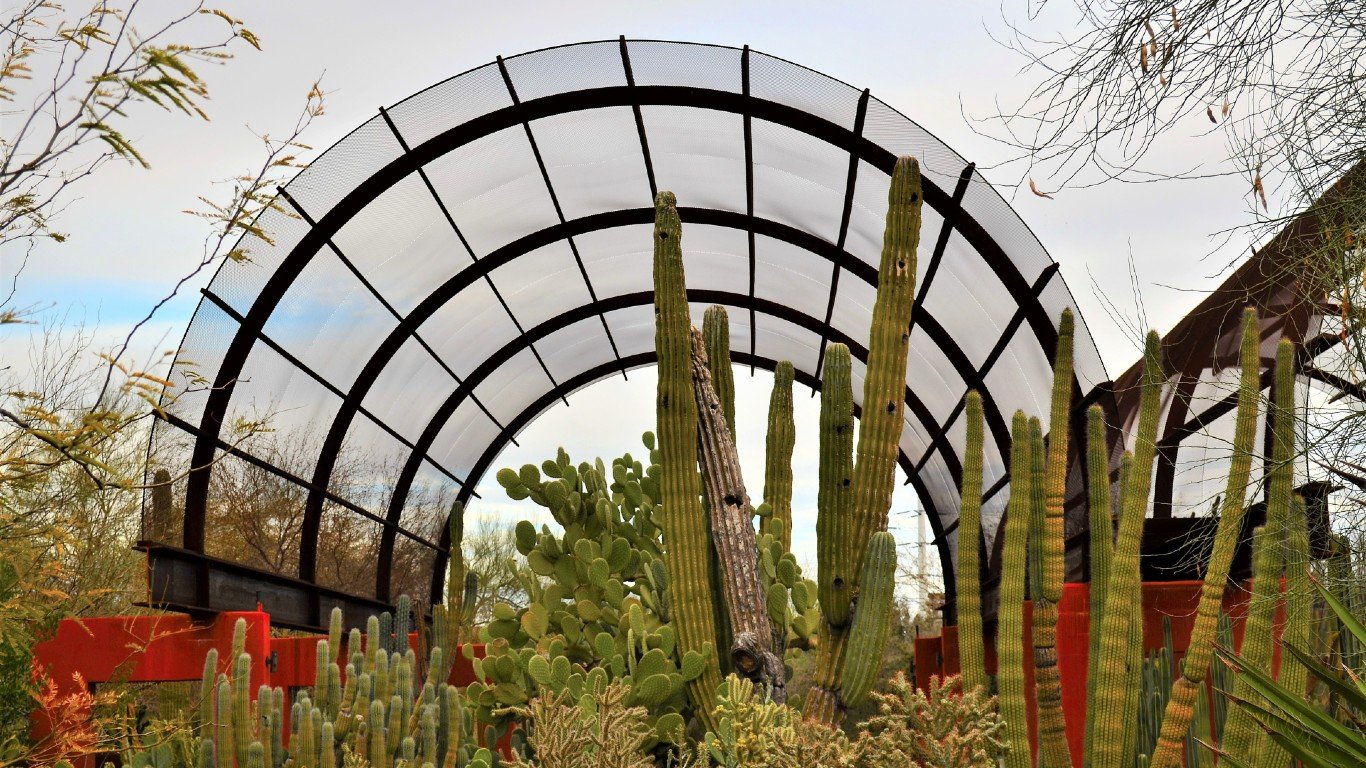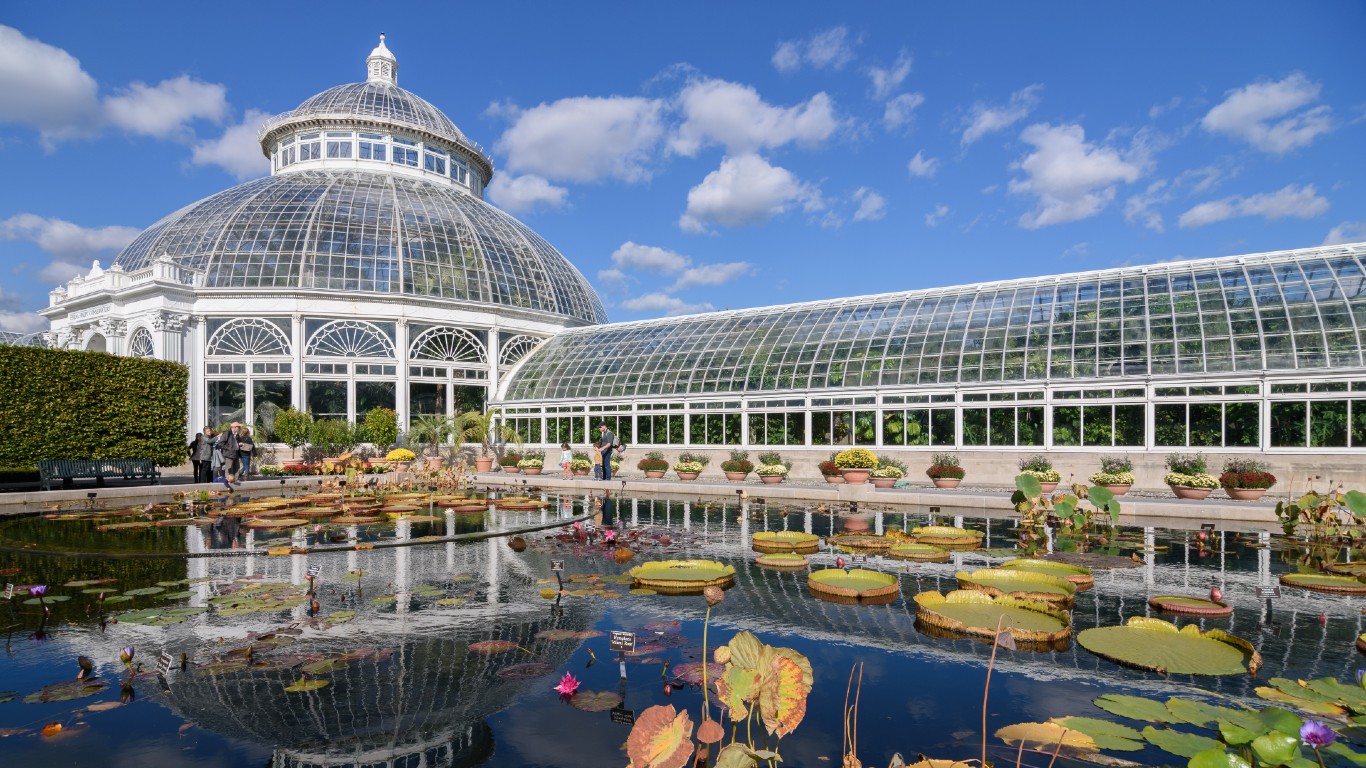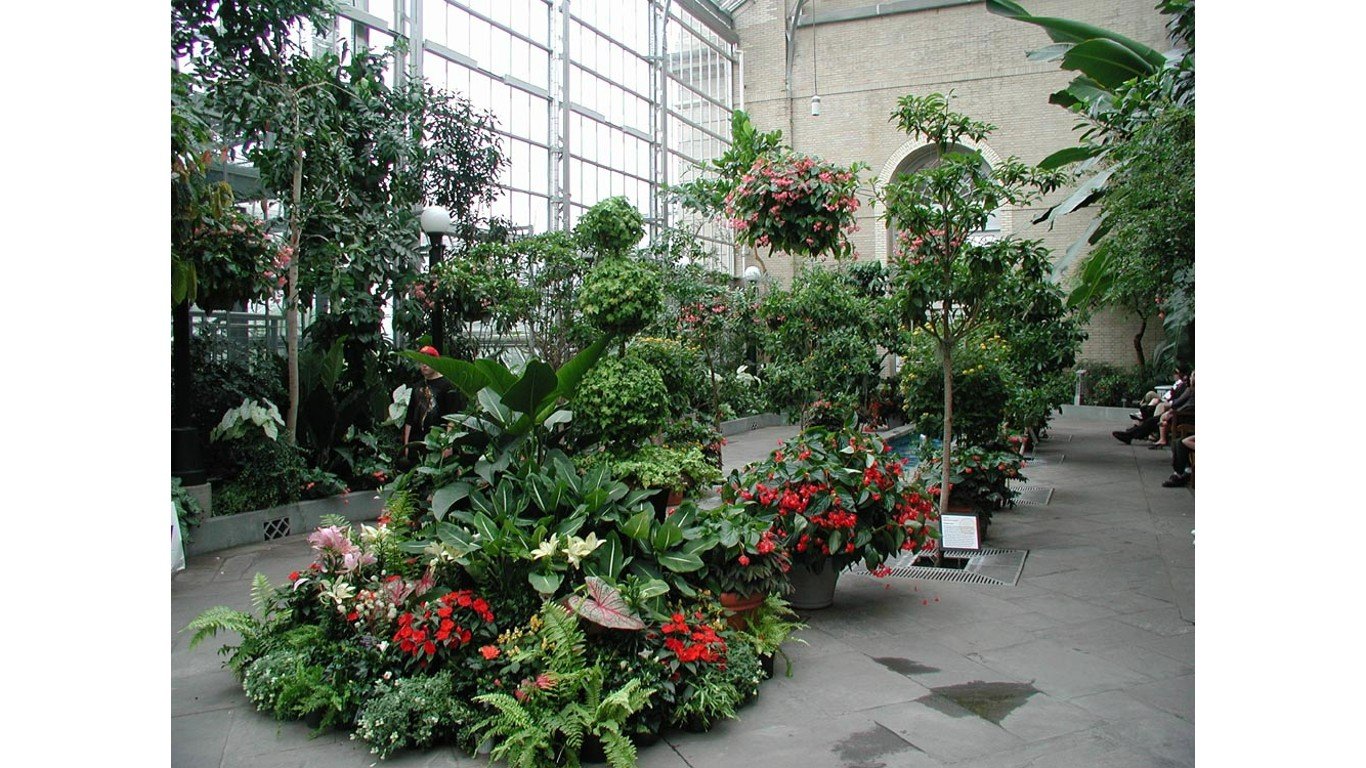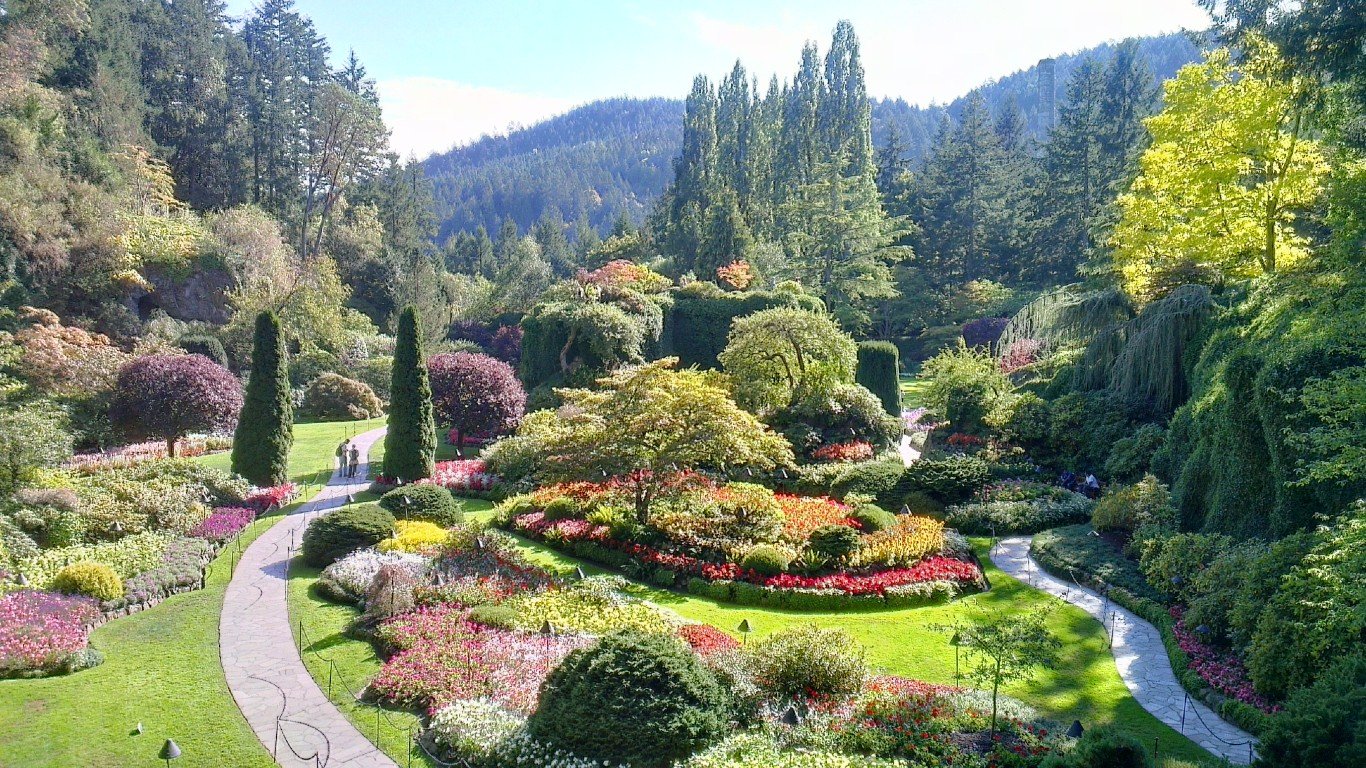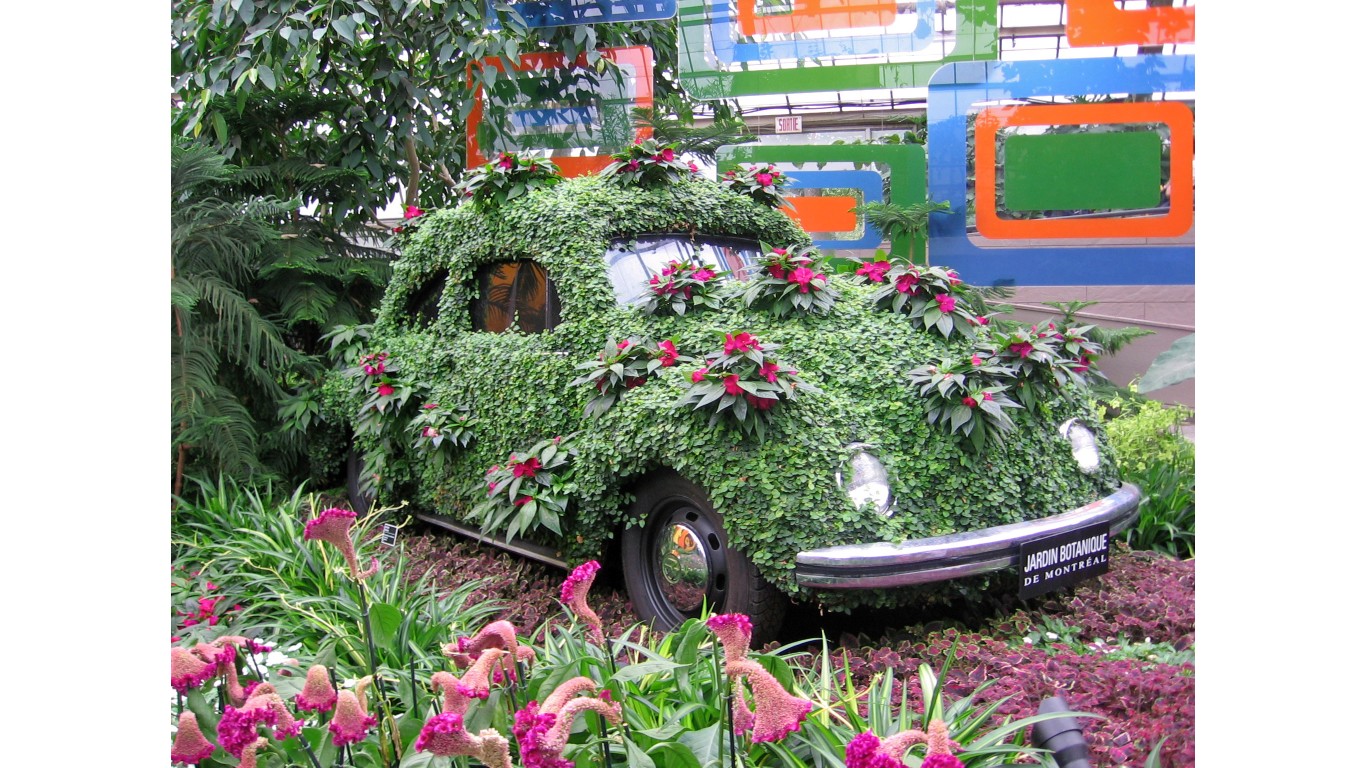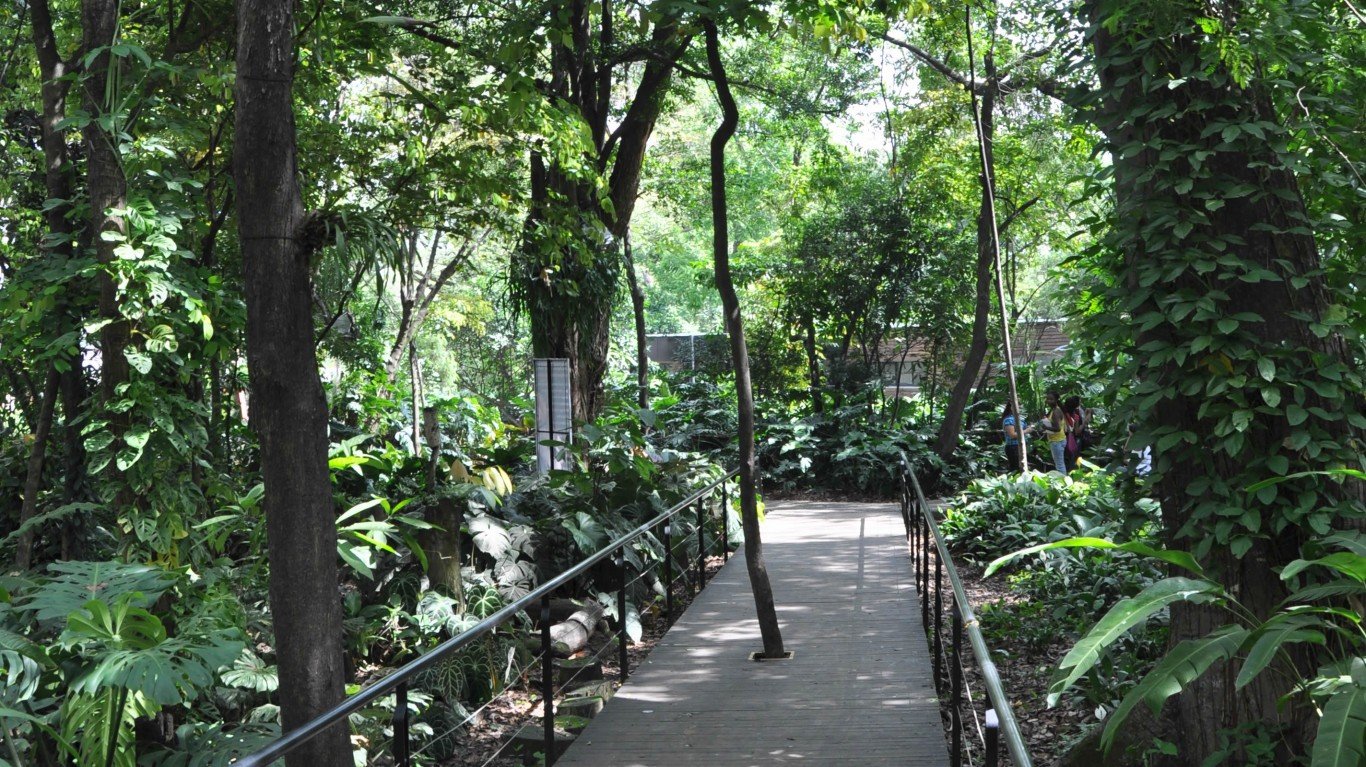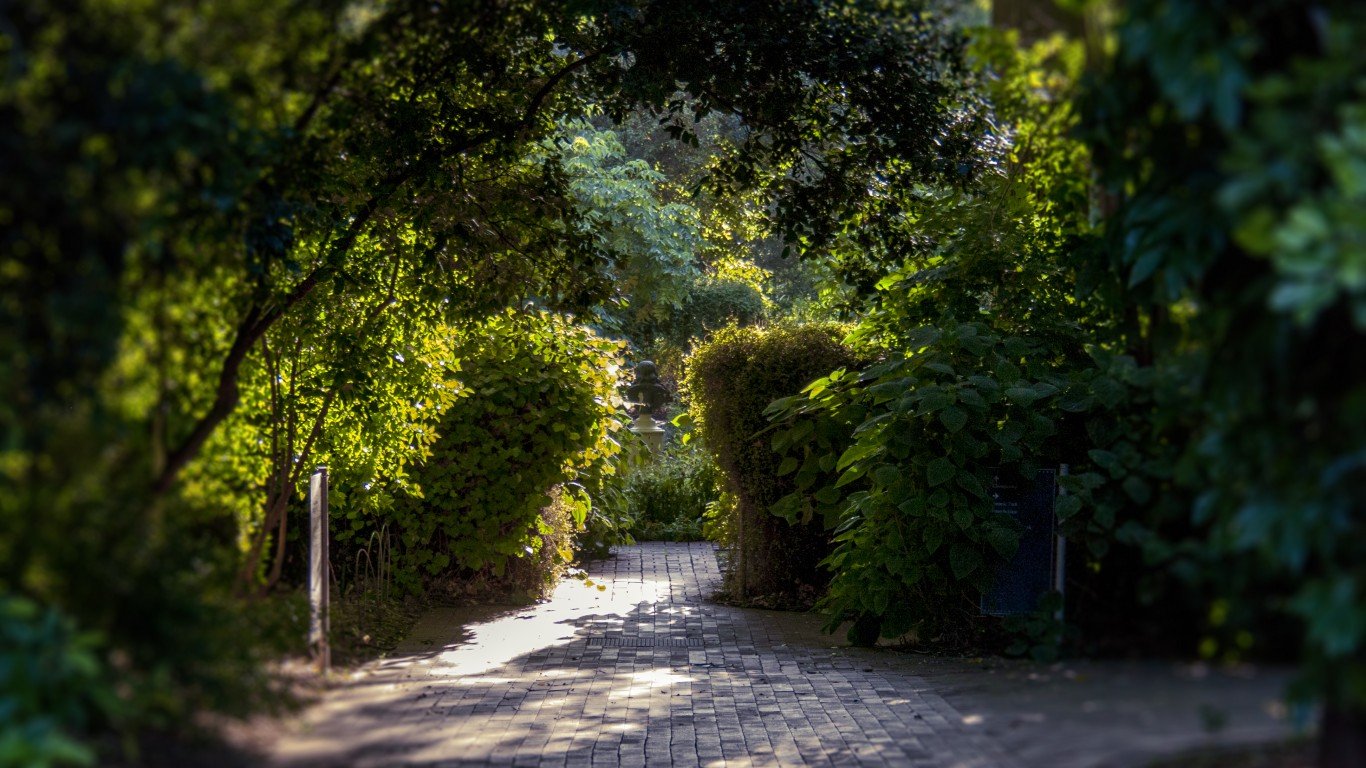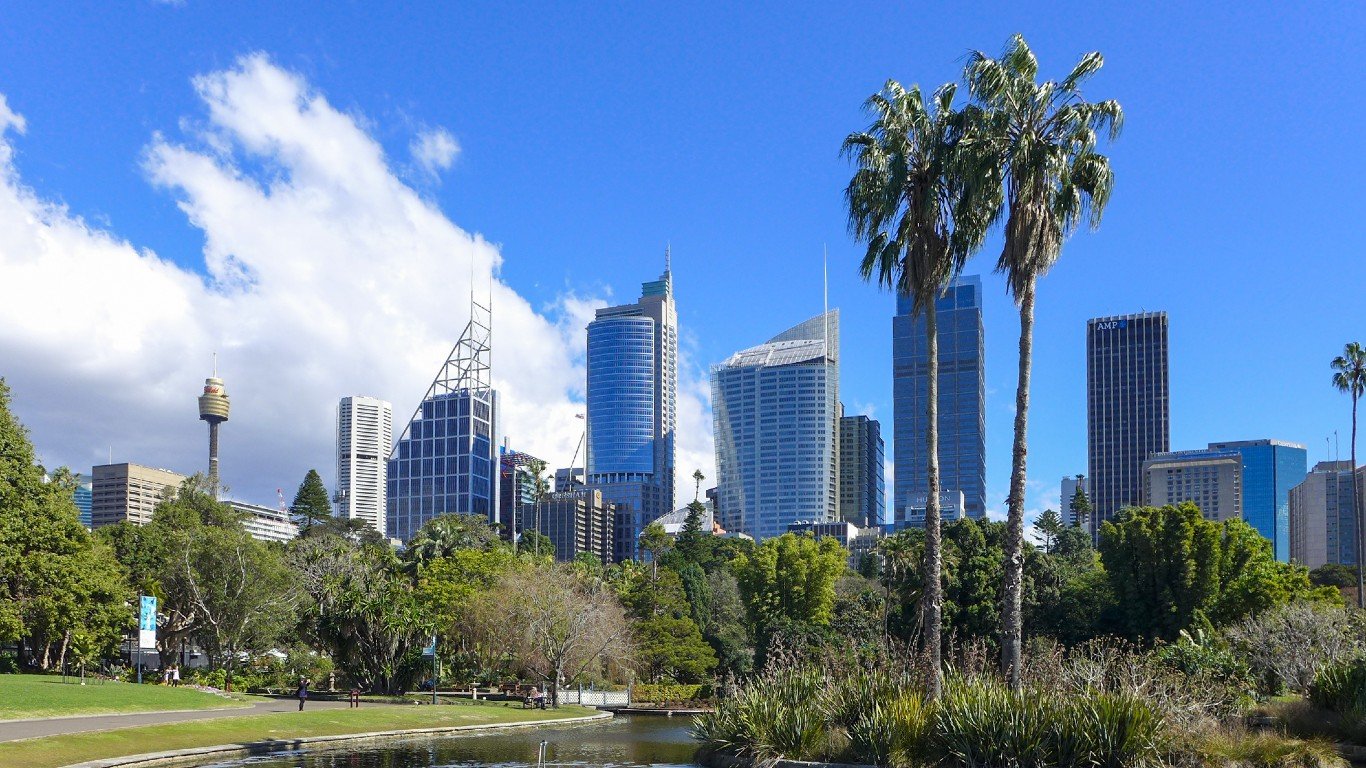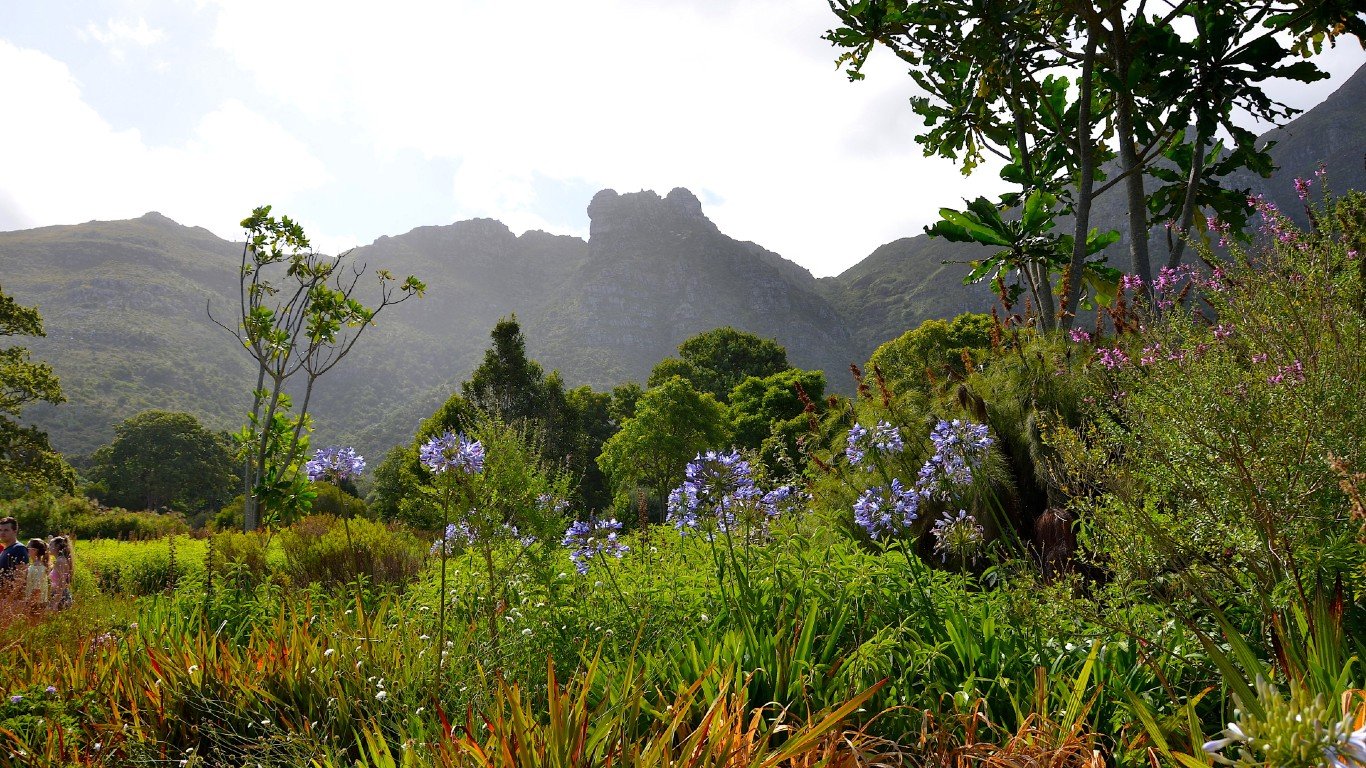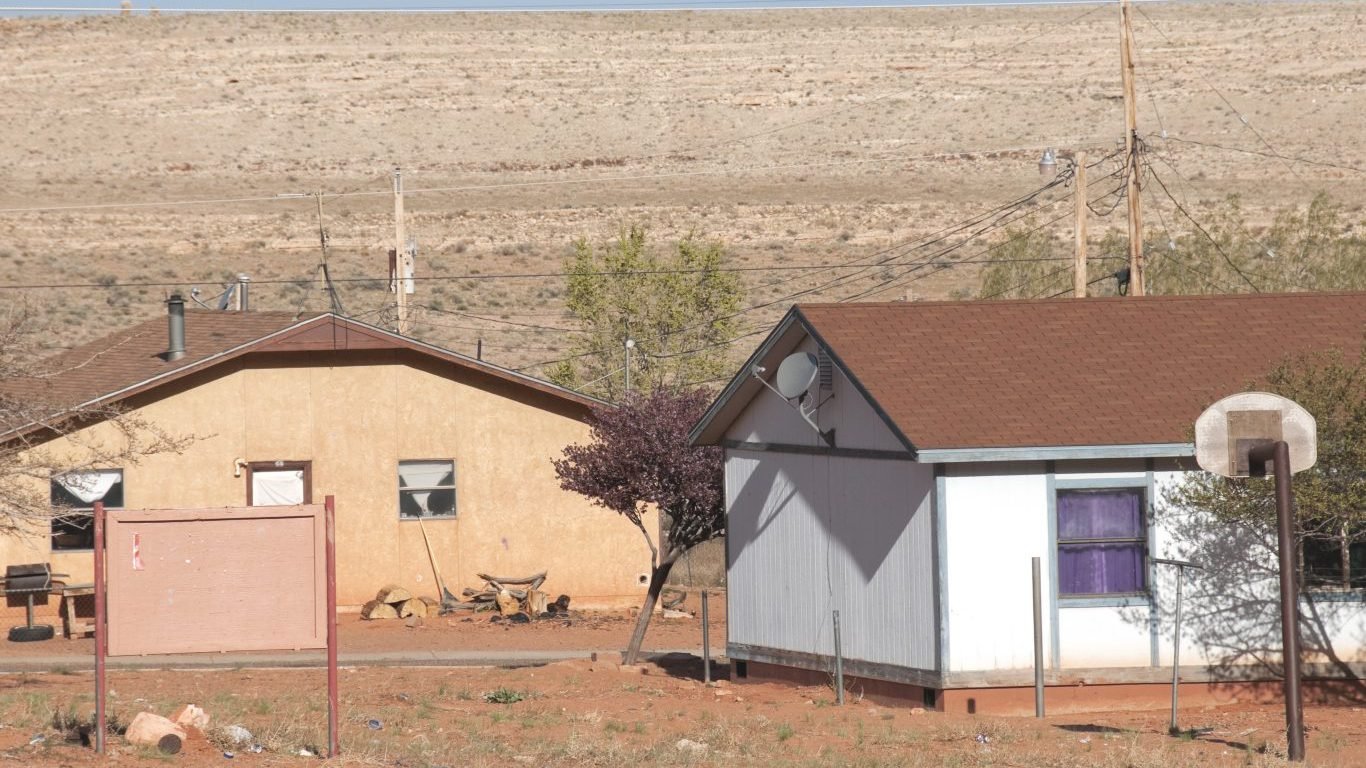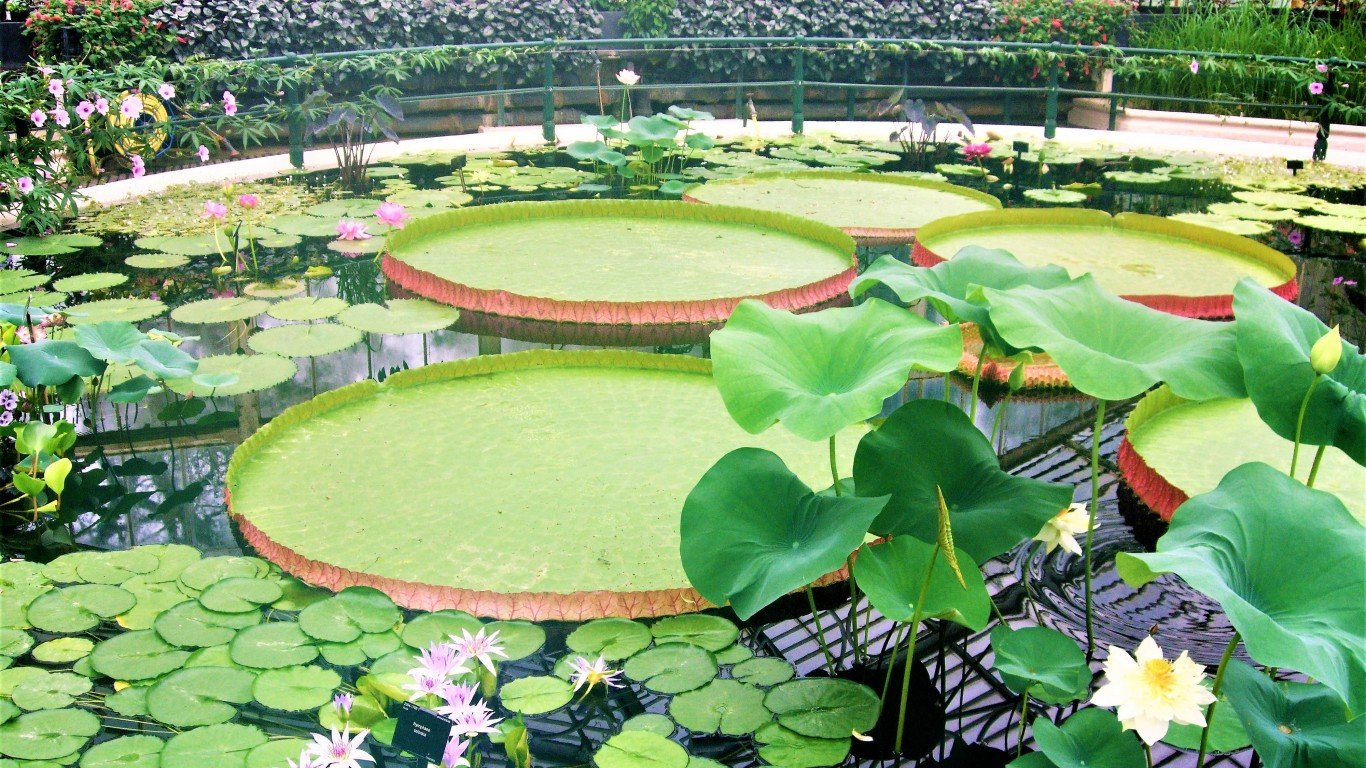

Often the greenest and most stunning places in an urban environment, botanical gardens serve as recreational areas where the public can interface with the natural world in a context that inspires awe and respect. These gardens serve as crucial verdant spaces in cities, not only for people, but for pollinators including bees, bats, butterflies, and birds. They also help to lower temperatures and filter air. (Speaking of urban green spaces, here are the best cities for urban gardening.)
Expressions of sheer beauty aside, botanical gardens have always served a greater purpose. Early plant collections called “physic gardens” were established in medieval Europe as research centers for discovering and teaching the medicinal and therapeutic qualities of plants. Some 19th-century botanical gardens were started in tropical and subtropical areas to catalog the diverse plants indigenous to that area. Now, herbariums that catalog thousands of species of flora are a part of nearly every major botanical garden.
In the 21st century, as we witness climate change and mass extinctions, the role of botanical gardens is shifting toward one of conservation. The protection and propagation of threatened, endangered, and native species and habitats has become paramount. Propagation facilities and seed banks are not uncommon in modern botanic gardens. (Here is the most threatened wildlife in every state.)
24/7 Tempo has compiled a list of the best botanical gardens in the world by reviewing articles on the subject appearing on numerous travel, gardening, and general interest websites, including Afar, Travel & Leisure, Wanderlust, Lonely Planet, Veranda, Time Out, Thrillist, Garden Design, Planted Well, and Balcony Garden Web.
Click here to see the best botanical gardens in the world
Some of the gardens on the list are free, state-sponsored parks, while others are private collections run on family estates. Many are the life work of a dedicated botanist and some have been rejuvenated from near-ruin. The best botanical gardens in the world span six continents and feature plants from nearly every biome on earth, from deserts to rainforests to high mountains.
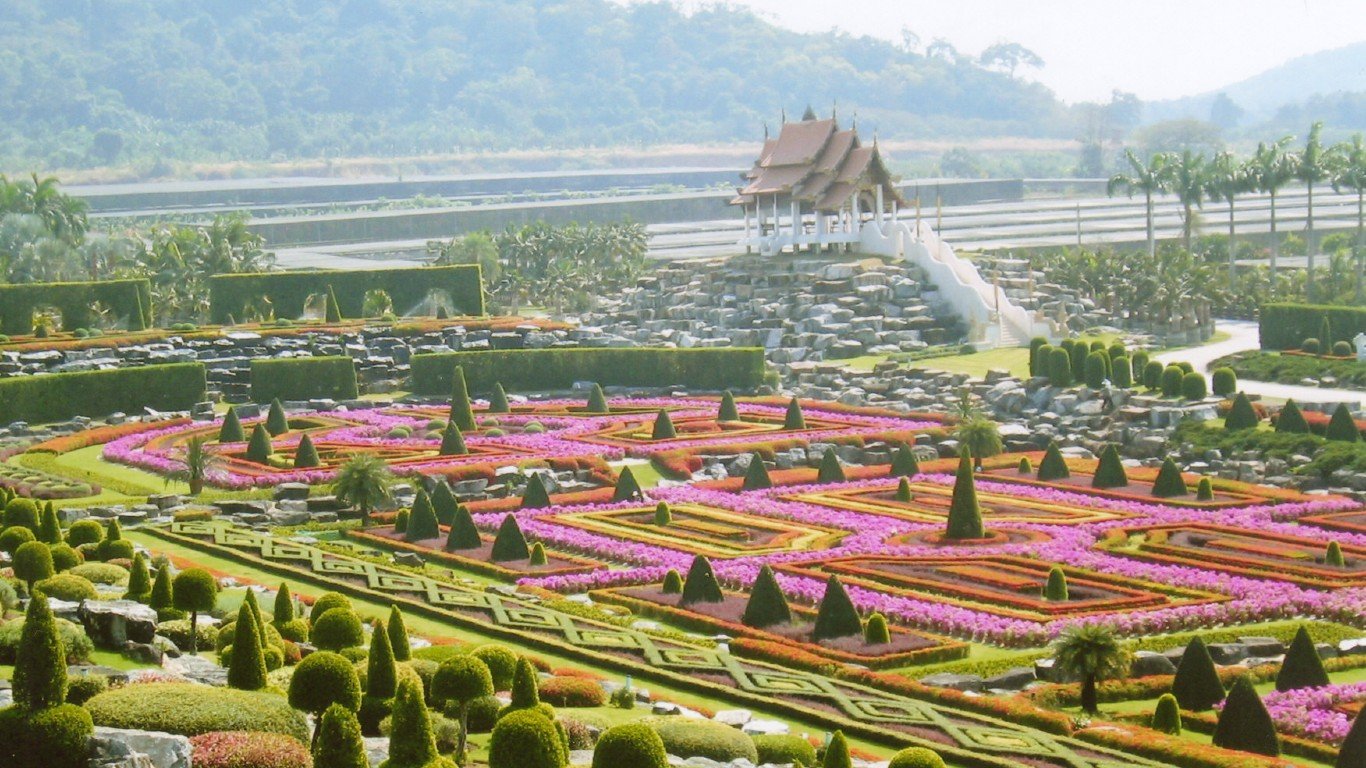
Nong Nooch Tropical Botanical Garden
> Location: Pattaya, Thailand
Founded in 1980, Nong Nooch is among the most extravagant of international tropical gardens. It’s a safe haven for delectable fruits and Jurassic-era cycads, while boasting a great variety of bromeliad and tillandsia flora — commonly known as air plants. The spiraling curvature of this garden is a seductive maze, venturing into nine individual realms including the Ant Tower, Butterfly Hill, Flower Valley, and Stonehenge gardens.
[in-text-ad]
Peradeniya Royal Botanical Gardens
> Location: Kandy, Sri Lanka
Formally established in 1843, this sculpturally dynamic garden bears a royal legacy dating back to 1371, during the rule of King Wickramabahu III. Its winding walkways are lined in swaths of color and unrivaled multi-level landscape architecture. It has gained renown for its long lineage of orchids and its 200-variety palm tree collection, best displayed along its avenues.
Singapore Botanic Gardens
> Location: Singapore
The history of this botanic garden is entwined with the history of Singapore itself. Beginning as a research garden for potential cultivation crops, it became a center of rubber plant experimentation prior to the area’s latex production boom. The garden’s public works role within the city has lent to Singapore’s moniker “Garden City” and in 2015 it became the only tropical garden on the UNESCO World Heritage list. Some gems on site include the National Orchid Garden, the Ethnobotany Garden, and a seed bank.
Jardin Majorelle
> Location: Marrakech, Morocco
Created by French artist Jacques Majorelle over a 40-year span and subsequently restored by fashion designer Yves Saint-Laurent and his partner, Pierre Bergé, this garden prioritizes unusual and rare plants amidst cubist architecture in shades of cobalt blue and teal. Villas run adjacent to various museums throughout the garden, with pathways leading to art exhibits, bird havens and an array of cacti and stunning fountain mosaics.
[in-text-ad-2]
Miracle Garden
> Location: Dubai, United Arab Emirates
Welcome to the largest flower garden in the world. Imagine the topiaries of Edward Scissorhands dotting a landscape dreamt up by Lewis Carroll, and you’ll come close to envisioning the flamboyant whimsy of this award-winning garden. Flowering shrubs in the shape of Disney characters, cottages, and castles punctuate the walkways; a flower clock is groomed daily to mimic mechanical motion; and an indoor sanctuary houses 15,000 butterflies of 26 species.
Arctic-Alpine Botanical Garden
> Location: Tromsø, Norway
The northernmost botanical garden in the world, this Norwegian garden is nestled between towering mountains and showcases rare alpine and arctic plants. Spectacular alpine blooms appear when the sun remains in the sky without rest between May and July. The garden is open year-round and requires no entry fee but it’s best to visit from May through October, before heavy snows arrive.
[in-text-ad]
Berlin-Dahlem Botanical Garden
> Location: Berlin, Germany
Berlin-Dahlem was established in the 17th century as a kitchen and brewery garden. In the early 19th century it was revamped into a research center and now contains a museum with an herbarium of 3.5 million specimens. Now the second largest botanical garden in the world, it boasts 20,000 plant species and 16 greenhouses. Highlights include the Cactus Pavilion, the giant bamboo forest, and the Pavilion Victoria, which features carnivorous plants, giant water lilies, and orchids.
Fondation Monet
> Location: Giverny, France
Here, the famous home and gardens that inspired impressionist painter Claude Monet have been preserved and renovated after being left untended, then partially destroyed by bombs during World War II. The two distinct gardens include a pond with water lilies and a Japanese bridge, as well as a garden called the Clos Normand which features flowers, arches, and an apple orchard.
The Gardens of Trauttmansdorff Castle
> Location: Merano, Italy
Dating back to 1850, the 30-acre gardens at Trauttmansdorff Castle offer mountain vistas and over 80 diverse landscapes. The gardens are themed by region and include a Mediterranean sun garden, formal Italian and English gardens, chestnut woodlands, and terraced water gardens. Peacocks, macaws, nonvenomous snakes, and goats wander the premises, and experiential stations add interest for children and botanists alike.
[in-text-ad-2]
Jardín Botánico Canario Viera y Clavijo
> Location: Gran Canaria, Canary Islands, Spain
Built around a waterfall and cliff face dotted with caves, these gardens on an archipelago off the coast of Morocco are the life work of botanist Erik Ragnar Svensson, whose aim was to preserve the heritage of the diverse plant species native to the Canary Islands. The 27 acres of gardens feature 500 endemic species — some on the verge of extinction — including 10,000 succulent cultivars, date palms, ornamentals, and a forest of the laurels that once covered the islands before they were wiped out after colonization by the Spanish.
Kew Gardens
> Location: London, England
This 330-acre garden and UNESCO World Heritage site is home to the largest botanical and fungal collection in the world. On site are a series of glass greenhouses and over a dozen ornamental buildings, as well as multiple galleries, museums, and scientific collections. The herbarium contains over 8.5 million preserved specimens. Highlights include the arboretum, rock garden, Japanese gardens, and Alpine House.
[in-text-ad]
Lautaret Alpine Botanical Garden
> Location: Grenoble, France
Located high in the Dauphine Alps of southeastern France, this alpine garden and herbarium features 2,300 species of plants from mountains around the world, as well as views of the Meije glaciers. The plants are organized by themes including habitat, medicinal or toxic properties, and geographical origin. The best time to visit is when the gardens are in peak bloom between early July and late September.
Ljubljana Botanical Garden
> Location: Ljubljana, Slovenia
Founded in 1810 as a sanctuary for native plants, Ljubljana Botanical Garden is home to 4,500 plant species and subspecies, a third of which are endemic to Slovenia. The grounds also feature a tropical greenhouse, an arboretum, a marsh, and a research facility. Admission to the garden, which serves as a peaceful walking park, is free but there is a small fee to enter the tropical greenhouse.
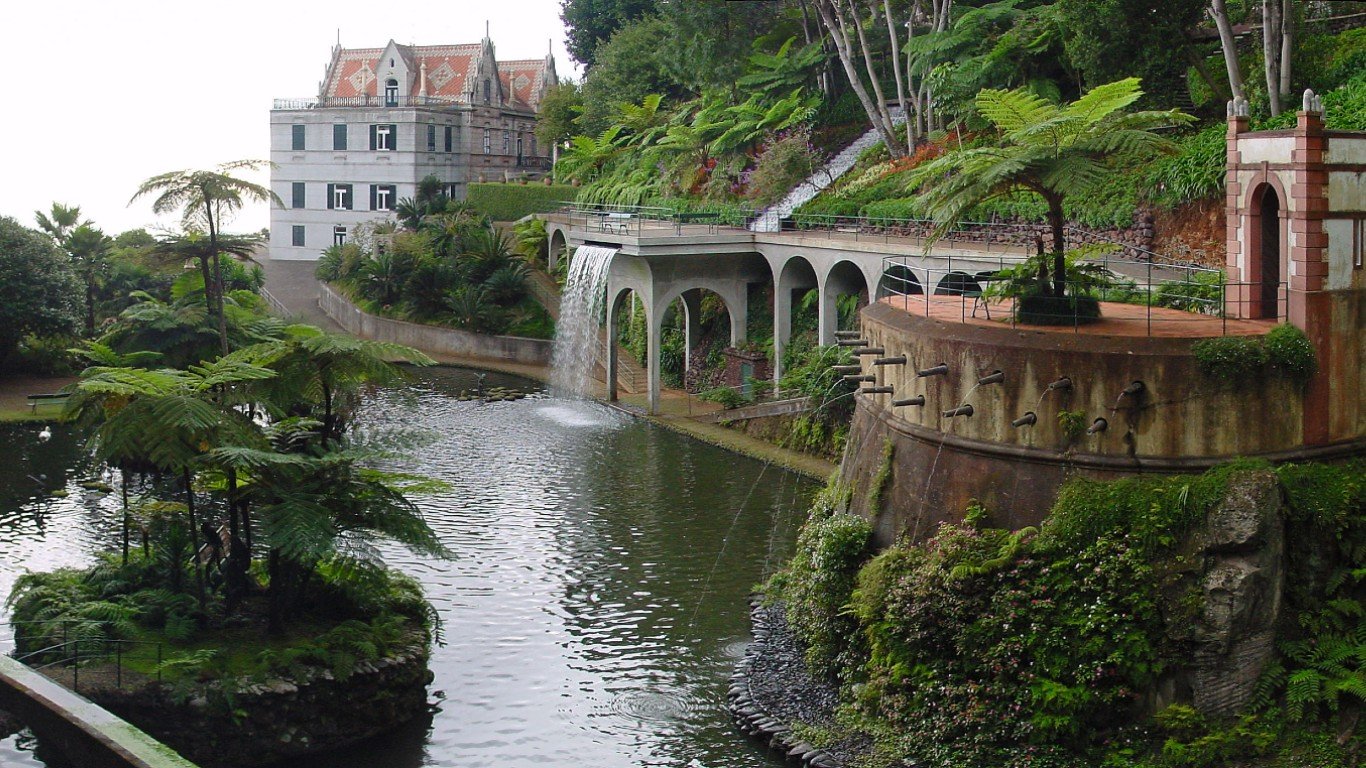
Monte Palace Tropical Garden
> Location: Funchal, Portugal
The grounds of Monte Palace on the island of Madeira compose a 17-acre tropical garden and art gallery. Flowering azaleas, orchids, and cycads serve as living frames around statues, terra cotta tilework, and sculptures. A Japanese garden with stone walkways and lanterns meanders through koi ponds, pagodas, and ornate bridges. Swans, ducks, and peacocks roam freely and a central lake adorned with an aqueduct and waterfall, and a museum featuring African artwork and gemstones adds to an already exquisite experience.
[in-text-ad-2]
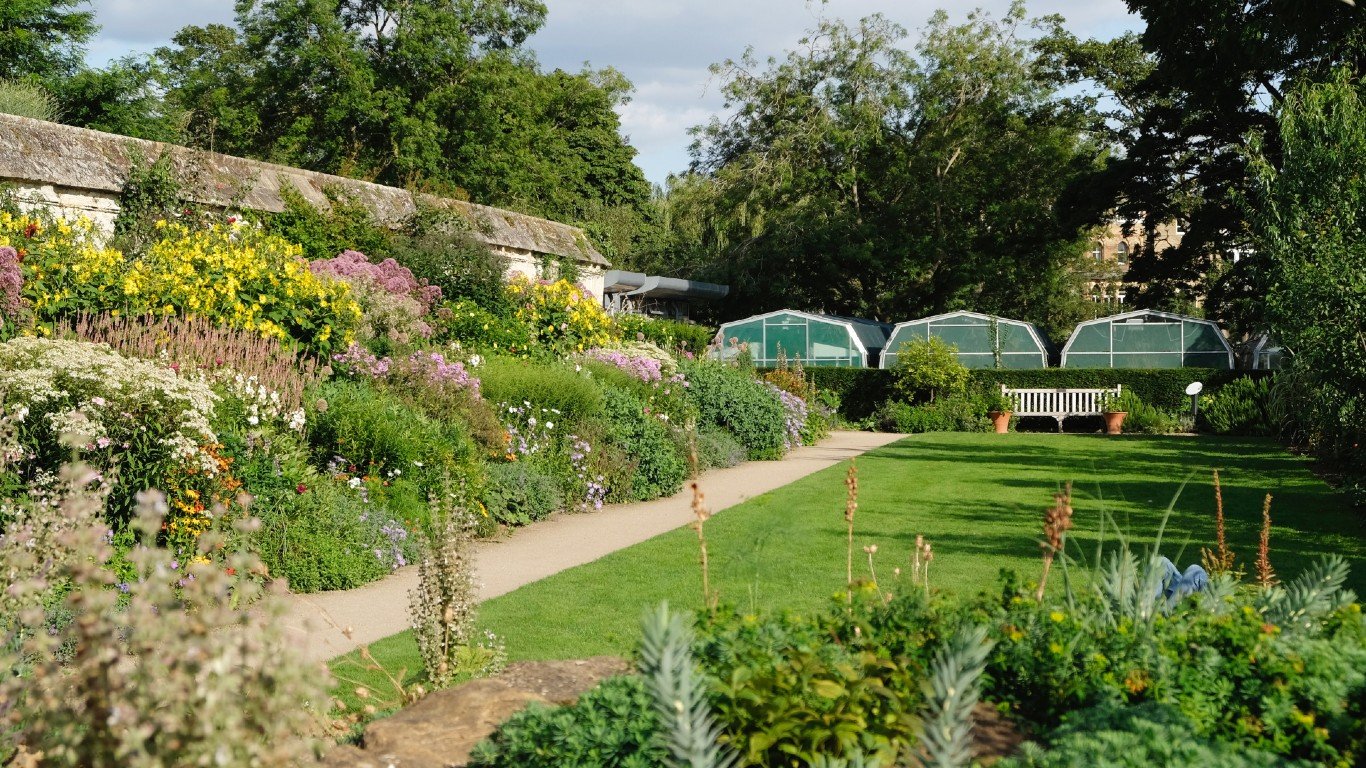
Oxford Botanical Garden
> Location: Oxford, England
The botanic garden at the University of Oxford, established in 1621, boasts one of the most diverse arrays of flora in the world, with a collection that represents over 90% of the vascular plant families on earth. In addition to a historic walled garden and an herbarium, the site features seven glasshouses that hold pristine collections of desert, rainforest, alpine, carnivorous, and forest canopy plants, including epiphytes.
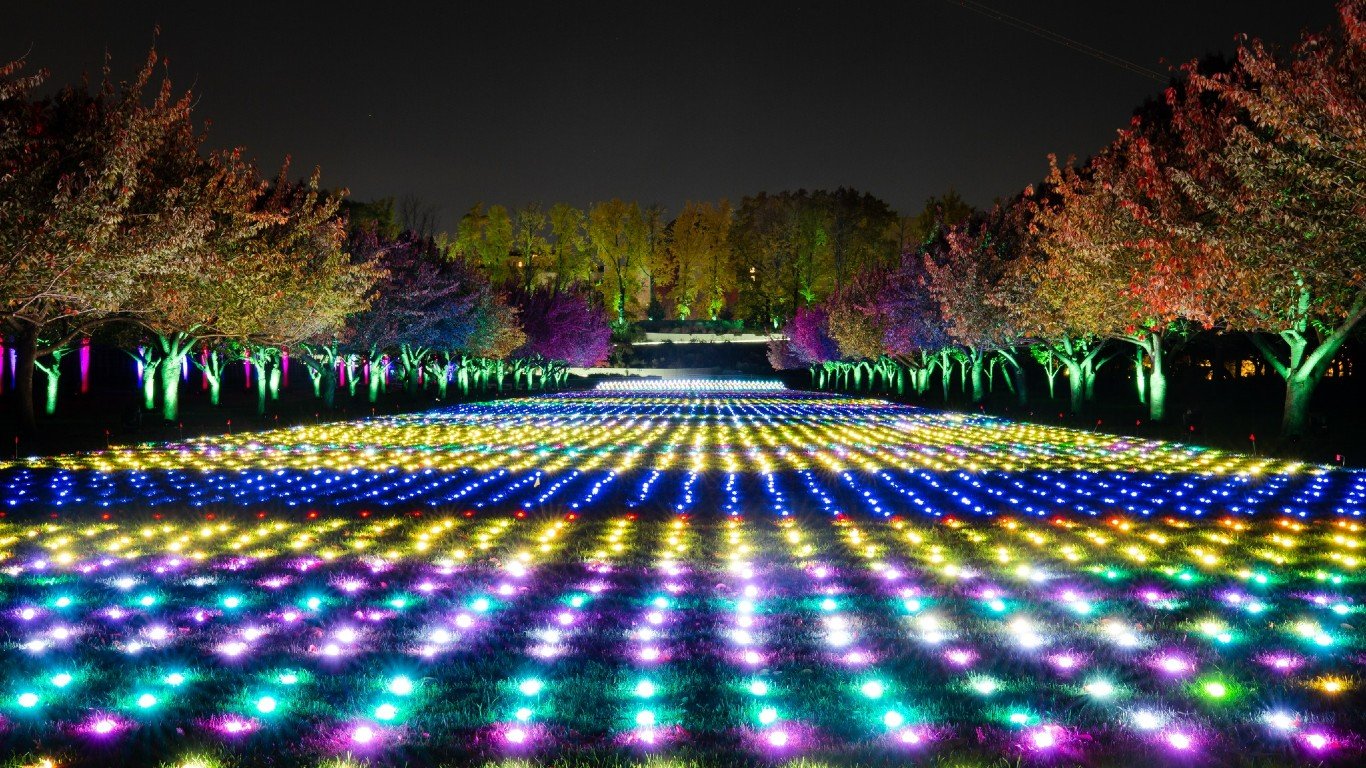
Brooklyn Botanic Garden
> Location: Brooklyn, New York, USA
Comprising 52 acres in central Brooklyn, this spectacular site has numerous themed gardens, the most popular of which are the Cranford rose garden, featuring 1,400 varieties of roses, and the flowering cherry esplanade, which boasts over 200 trees for a cherry blossom experience rivaling those in Japan. A native flora garden, multiple climate-themed pavilions, a Shakespeare garden, and a fragrance garden are just some of the other features that draw nearly a million visitors to the BBG annually.
[in-text-ad]
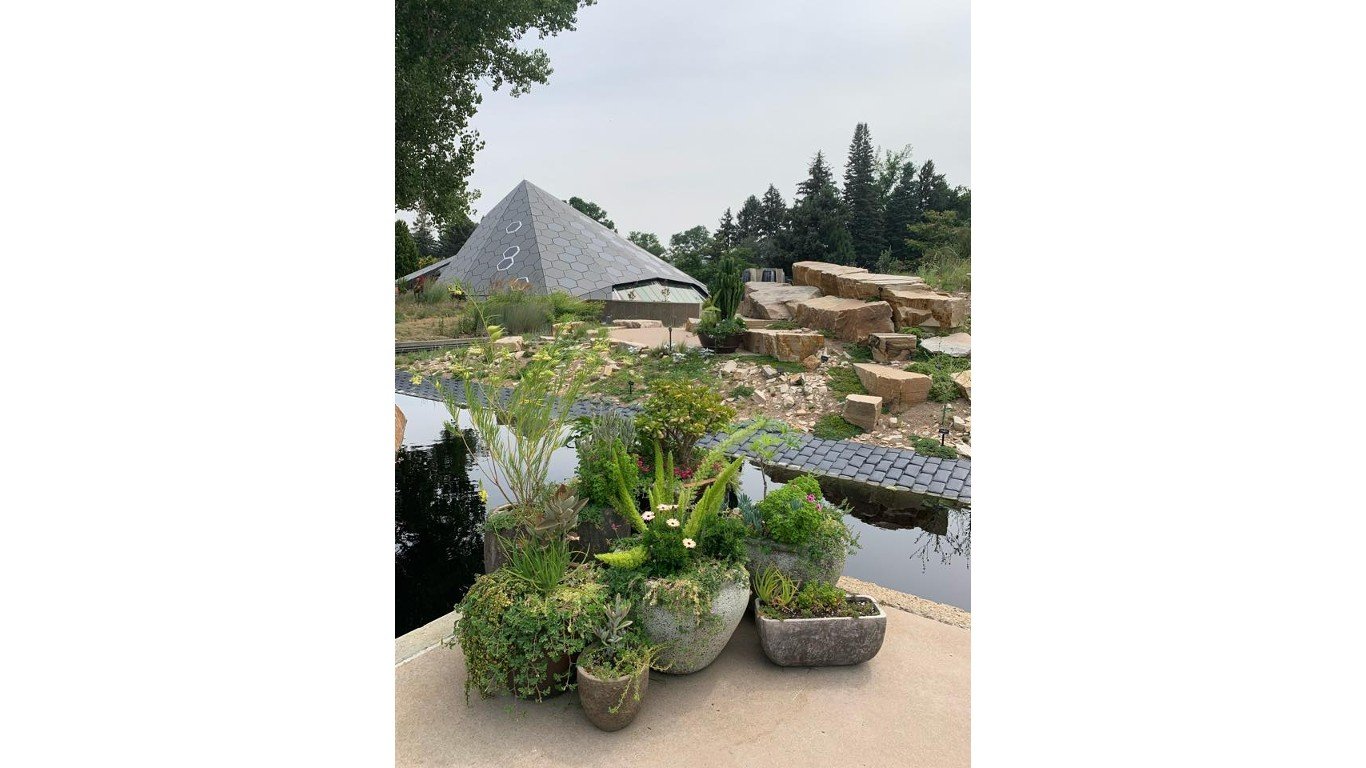
Denver Botanic Gardens
> Location: Denver, Colorado, USA
Located in an arid region of the western United States, the Denver Botanic Gardens utilize water conservation when possible, as demonstrated in their Dryland Mesa “xeriscape” (low or no irrigation) garden. The 23 acres of flora include areas featuring high desert and Rocky Mountain plants native to Colorado and the surrounding states. An amphitheater, award-winning tropical conservatory, and South African plant exhibit are also highlights of the gardens, which comprise three separate grounds around Denver.
Desert Botanical Garden
> Location: Phoenix, Arizona, USA
Be ready to walk at this 140-acre preserve arranged around themed hiking trails. Explore native Sonoran Desert plants in a variety of habitats including high chaparral, grassland, and mesquite bosque; or check out the Australian, Baja, and South American desert collections. A desert wildflower trail leads to a butterfly pavilion, and multiple living exhibits display medicinal and edible plants and their historic uses. Over 300 of the species on display are rare, threatened, or endangered.
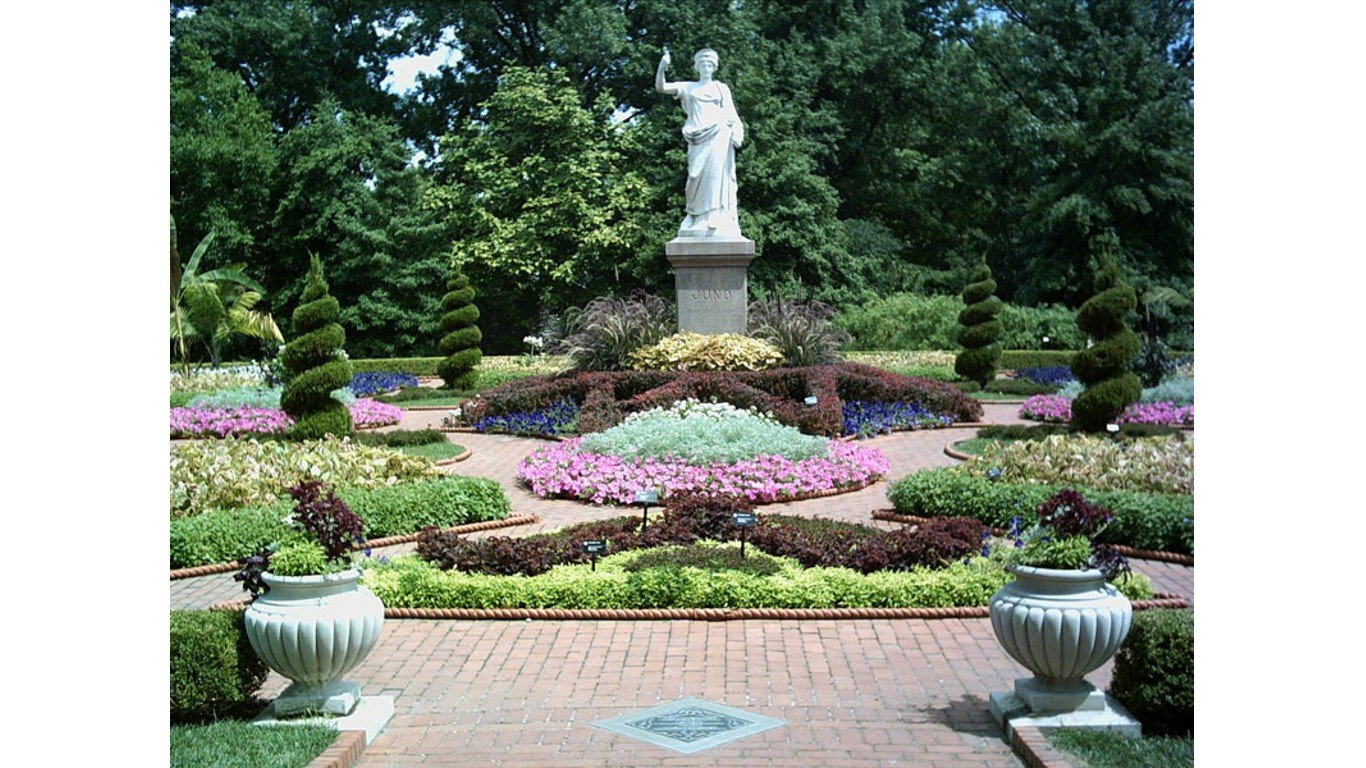
Missouri Botanical Garden
> Location: St. Louis, Missouri, USA
The former estate of businessman and amateur botanist Henry Shaw, the Missouri Botanical Garden features historic sculptures and buildings including the world’s first geodesic dome greenhouse. Exhibits of note are the tropical rainforest conservatory; a biblical garden containing date palms, olive trees, and other plants mentioned in the Bible; and a 14-acre Japanese garden — the largest in North America.
[in-text-ad-2]
New York Botanical Garden
> Location: The Bronx, New York, USA
Visitors may need multiple days to explore all that the New York Botanical Garden has to offer. From the largest herbarium in the United States, to the 250-acre grounds including 50 acres of old growth forest and 50 different gardens, to the rotating art and horticultural exhibits, this world-class botanic garden is a place to bring the whole family. Copious walking trails as well as indoor exhibits make the NYBG a year-round destination.
United States Botanic Garden
> Location: Washington, D.C., USA
Free and open to visitors every day of the year, the U.S. Botanic Garden campus comprises three sections: the 29,000-square-foot conservatory, the impeccably landscaped walking paths at Bartholdi Park, and the National Garden. Rooms in the climate-controlled conservatory feature exhibits such as the primeval garden of Jurassic-era plants, a collection of over 5,000 orchids, and a rainforest that reaches 93 feet high, with a mezzanine for viewing the canopy.
[in-text-ad]
The Butchart Gardens
> Location: Brentwood Bay, British Columbia, Canada
This family-run estate on Brentwood Bay, on the coast of Vancouver Island, has been a floral haven since the early 20th century. The historic Japanese garden was established around 1910, and the sunken garden was built next over an exhausted limestone quarry. Eventually, Italian gardens and a rose garden were put in, along with multiple fountains and a carousel. The end result is an enchanting floral display that was designated a National Historic Site in 2004.
Montreal Botanical Garden
> Location: Montreal, Quebec, Canada
The 190-acre grounds of the Montreal Botanical Garden display over 21,000 plant species and cultivars in one of the most extensive collections in the world. Over 30 thematic gardens and 10 exhibition greenhouses cover geographical and cultural collections including bonsais, roses, a First Nations garden, and a Ming Dynasty Chinese garden. While the greenhouses are open year-round, the outdoor gardens are generally covered in snow from November to April.
Buenos Aires Botanical Garden
> Location: Buenos Aires, Argentina
Designed by a French architect in the late 19th century, this botanic garden is a throwback to earlier times. Visitors can venture into a Roman garden featuring trees of the kind that Pliny the Younger grew at his mountain villa, or step into an Art Nouveau tropical greenhouse. Sculptures abound. Plants native to Argentina are on display in the Indigenous Americas garden and a beloved population of cats (who are cared for by volunteers) wander the grounds.
[in-text-ad-2]
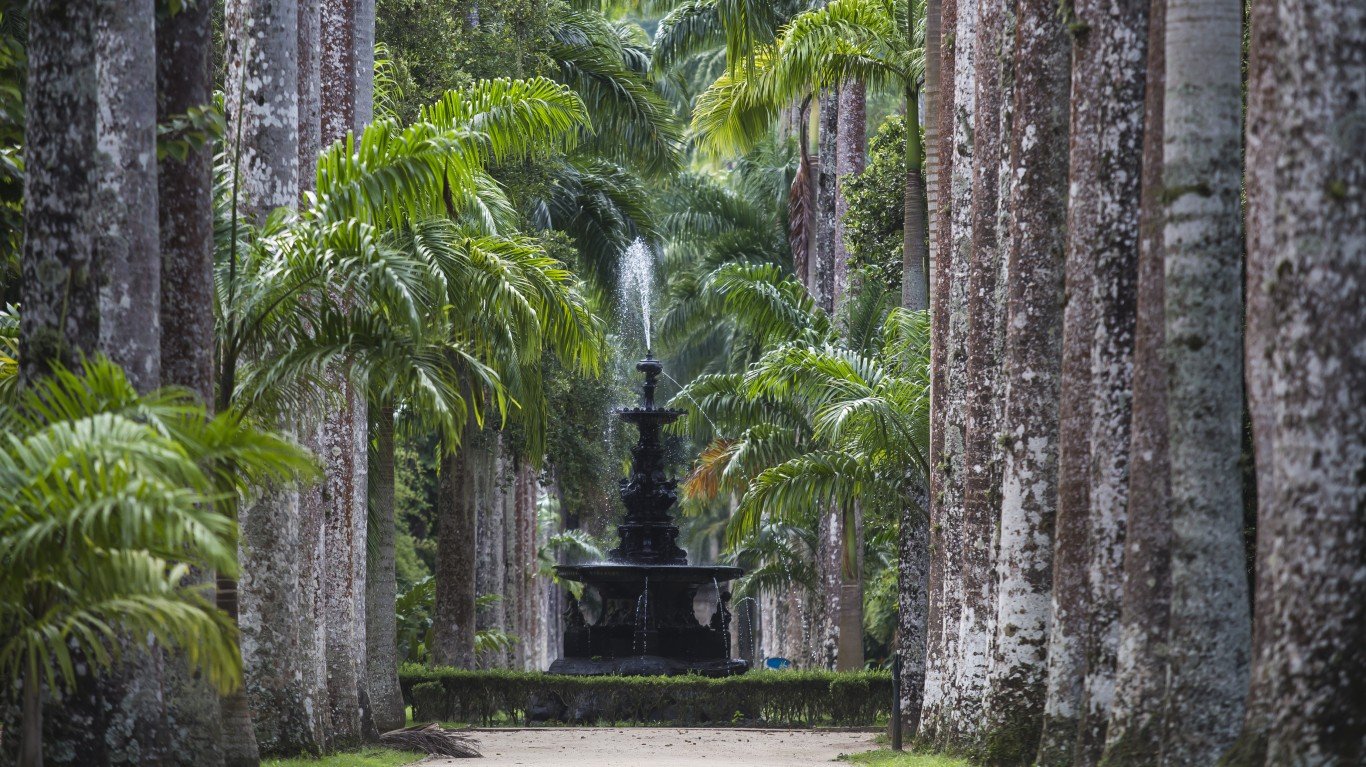
Jardim Botânico
> Location: Rio de Janeiro, Brazil
With only 40% cultivated plants on site, a defining feature of this botanic garden is the endemic Brazilian forest that makes up the other 60%. It is home to 140 bird species including the channel-billed toucan as well as marmosets and black capuchin monkeys that can all be seen from the paths that wind between rainforest trees. Tropical and subtropical plants such as rubber, cacao, and 900 varieties of palm trees grace the grounds.
Joaquin Antonio Uribe Botanical Garden
> Location: Medellín, Colombia
With collections designed to promote education and conservation, Medellín’ botanical garden is arranged as a living museum, and is home to over 100 bird species. In addition to a library and herbarium, the gardens contain a butterfly house, orchid collection, cactus garden, and numerous other exhibits focusing on the flowering plants of Colombia — one of the most biodiverse countries in the world.
[in-text-ad]
Adelaide Botanic Garden
> Location: Adelaide, Australia
Open 365 days a year and free to the public, the Adelaide Botanic Garden consists of 130 acres of gardens, architecture, and sculptures in the Adelaide city center. Visitors can wander through a Victorian glasshouse of Madagascar arid plants, a waterlily pavilion, and the National Rose Trial Garden. A new wetland area was constructed in 2011 to utilize diverted rainwater and limit the garden’s reliance on potable water. The gardens also feature a rare plant species called Wollemi pine, which was thought to be extinct until it was rediscovered in 1994.
Royal Botanic Gardens
> Location: Sydney, Australia
This public recreational area on Sydney harbor offers not only a verdant floral park full of colorful wildlife and native plants, but also views of the Sydney Opera House; world-class azalea, palm, and succulent gardens; and opportunities for immersion into the culture of the Aboriginal Cadigal people who traditionally inhabited the area. A horticultural arena called the Calyx houses rotating exhibits and one the largest green walls in the Southern Hemisphere.
Auckland Botanic Gardens
> Location: Auckland, New Zealand
As the flora of New Zealand evolved for millions of years in isolation, the islands contain over 30 plant genera that are found nowhere else in the world. The collections at Auckland Botanic Gardens feature many of these endemic plants. The Totara Park Native Forest contains over 170 native species while the Gondwana Arboretum displays a diversity of ancient conifers (including the kauri and Norfolk pine), massive ferns, and cycads that thrived millions of years ago. A harakeke (New Zealand flax) exhibit preserves numerous Phormium varieties traditionally used by the Maori for weaving.
[in-text-ad-2]
Kirstenbosch National Botanical Garden
> Location: Cape Town, South Africa
Dedicated to the cultivation of indigenous plants, Kirstenbosch Botanical Garden houses collections of South African plants that thrive in the distinct biomes of the country including savannah, karoo (semi-desert), and fynbos (coastal heathland). A large collection of South African flowering Protea, or sugarbush, are in bloom from late autumn into winter (May through August), while spring (September and October) brings the largest swaths of color to this incredibly biodiverse garden.
Take This Retirement Quiz To Get Matched With An Advisor Now (Sponsored)
Are you ready for retirement? Planning for retirement can be overwhelming, that’s why it could be a good idea to speak to a fiduciary financial advisor about your goals today.
Start by taking this retirement quiz right here from SmartAsset that will match you with up to 3 financial advisors that serve your area and beyond in 5 minutes. Smart Asset is now matching over 50,000 people a month.
Click here now to get started.
Thank you for reading! Have some feedback for us?
Contact the 24/7 Wall St. editorial team.
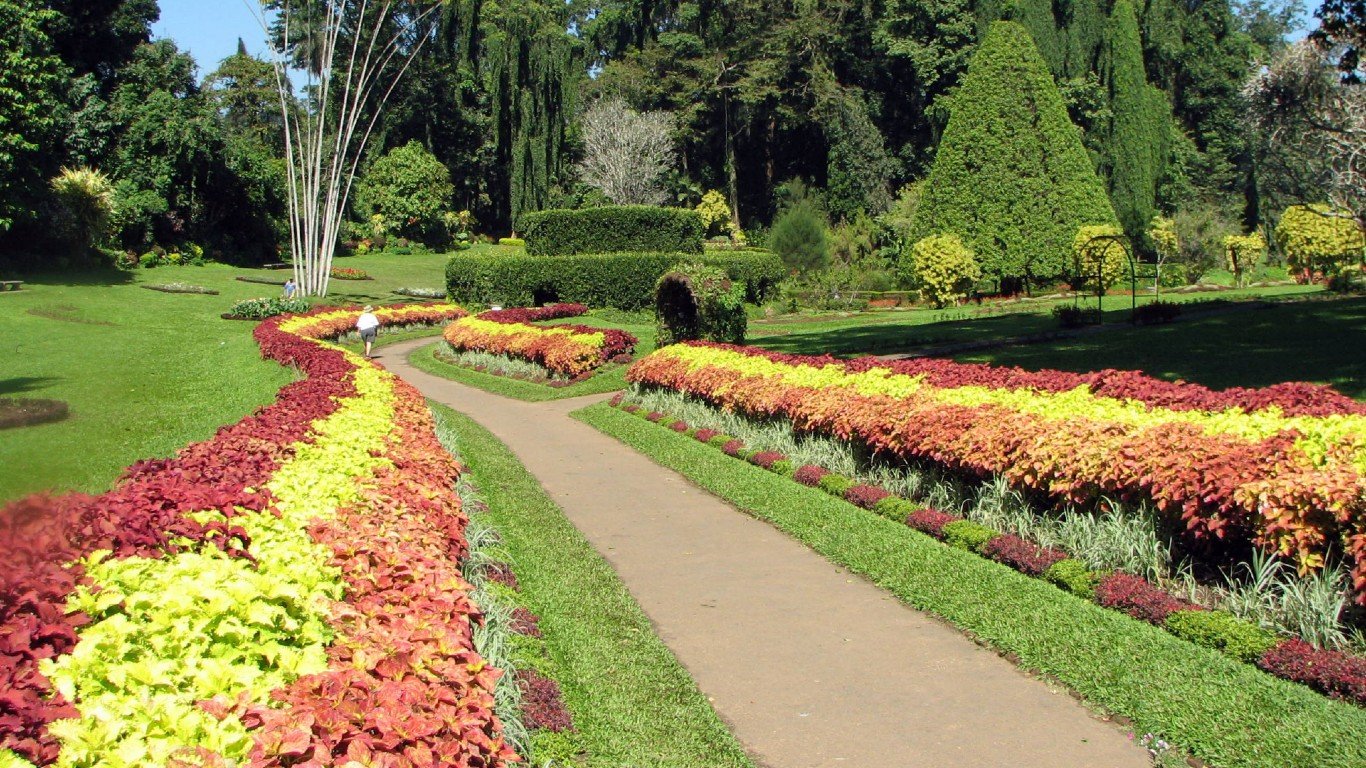
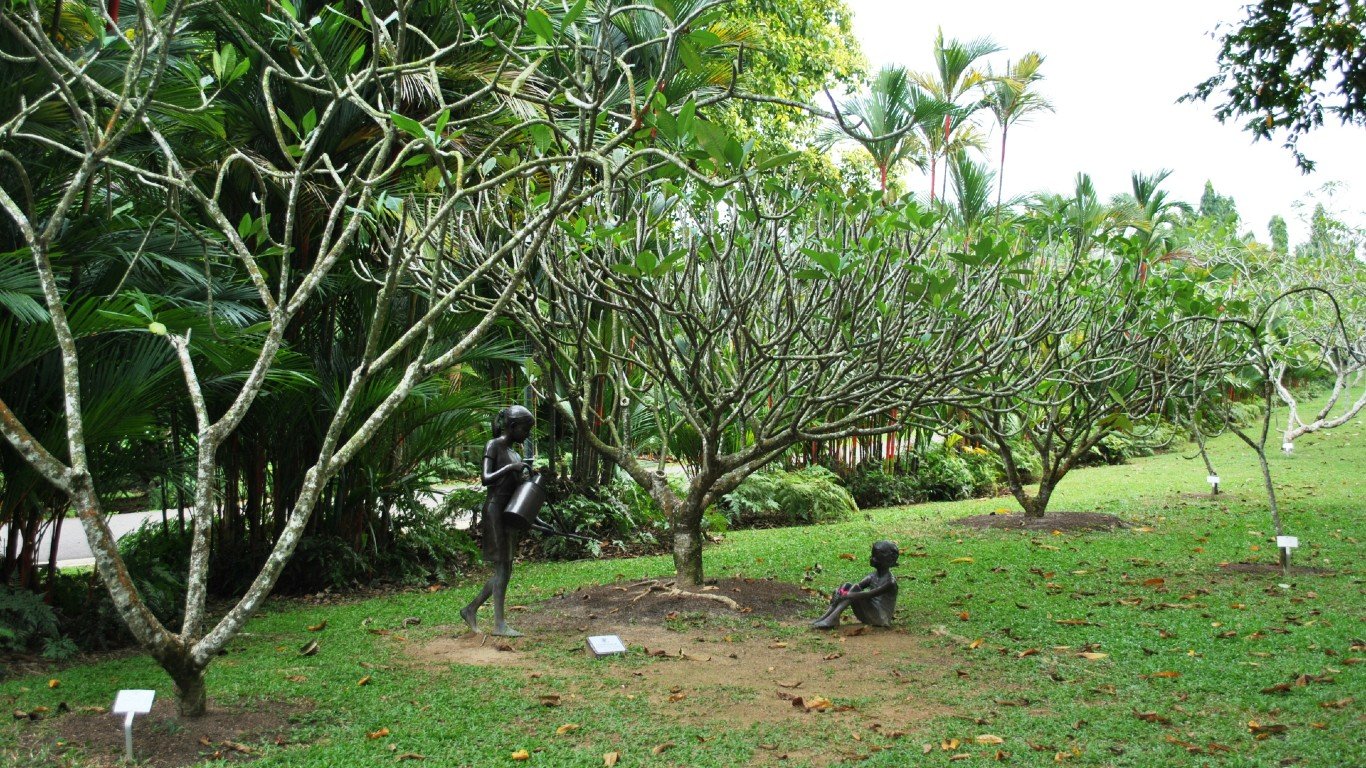
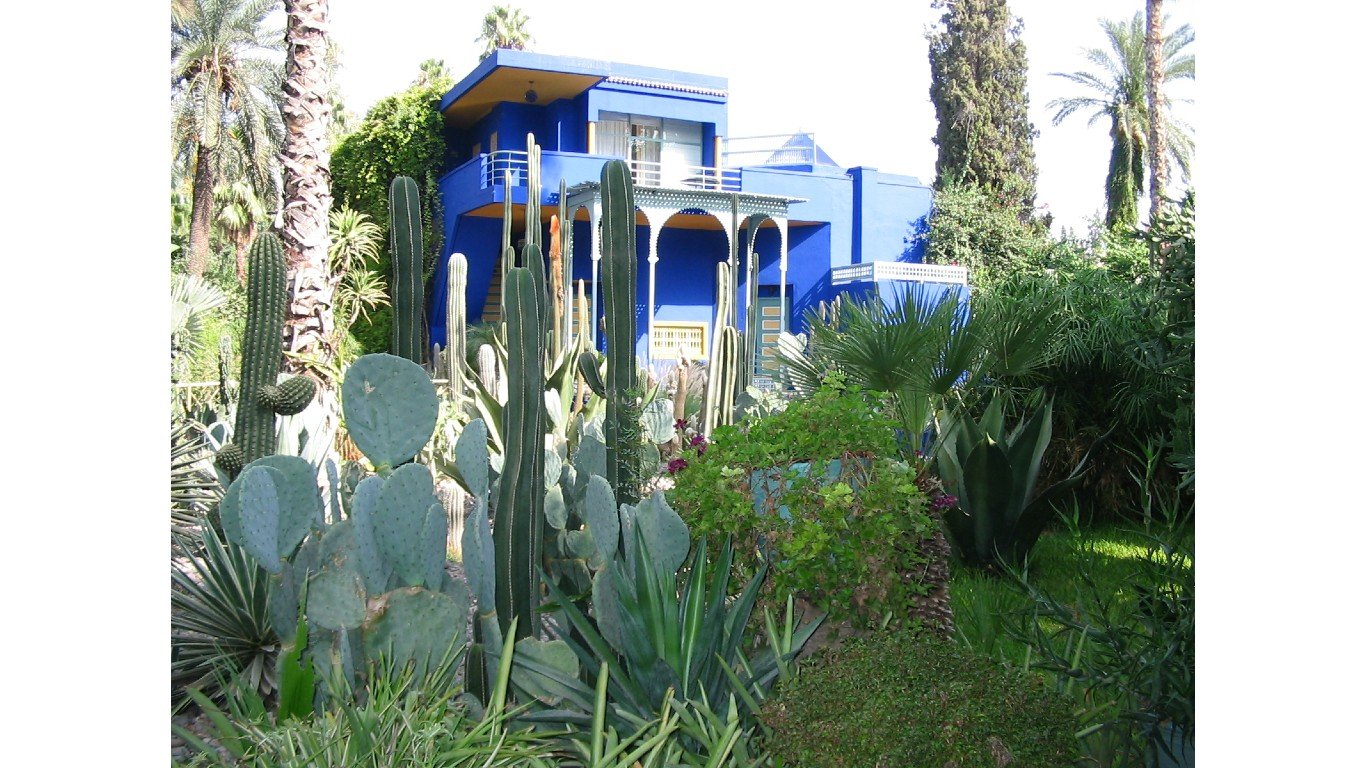
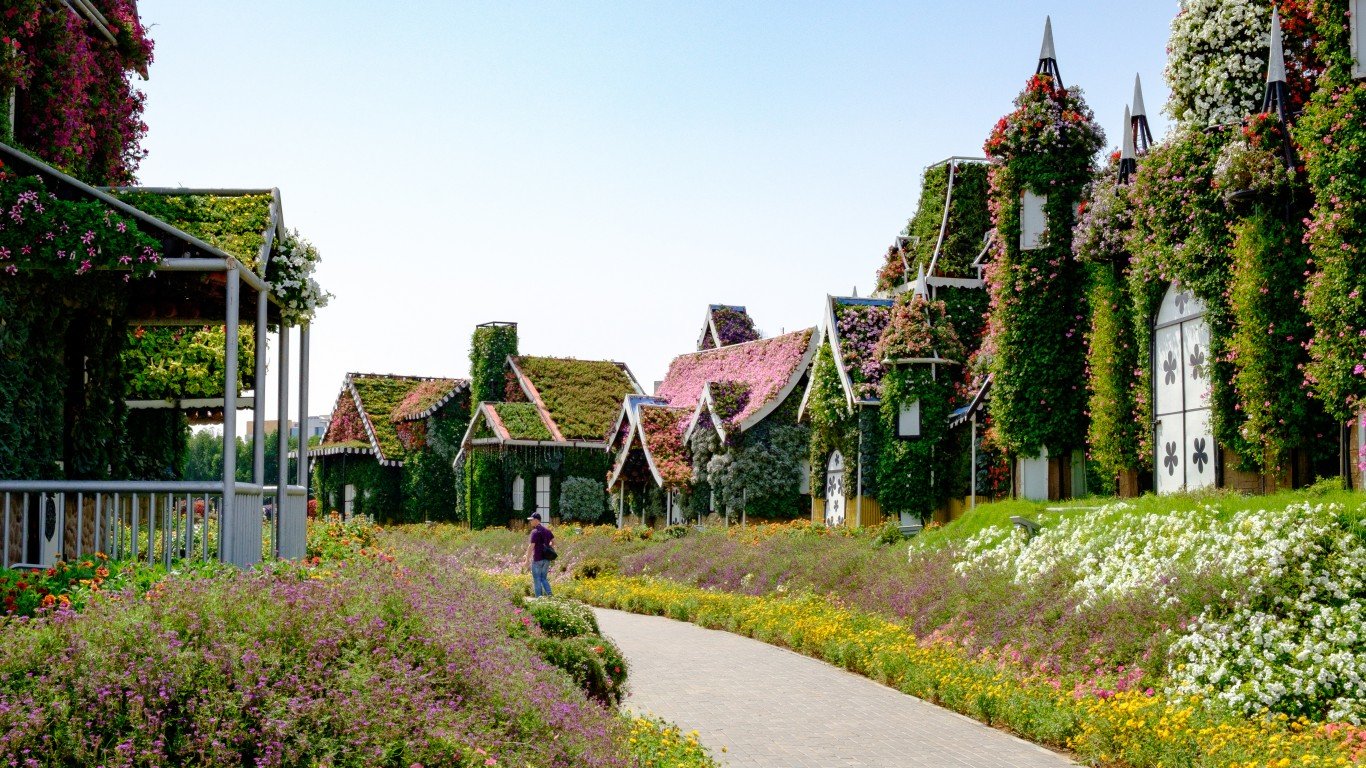
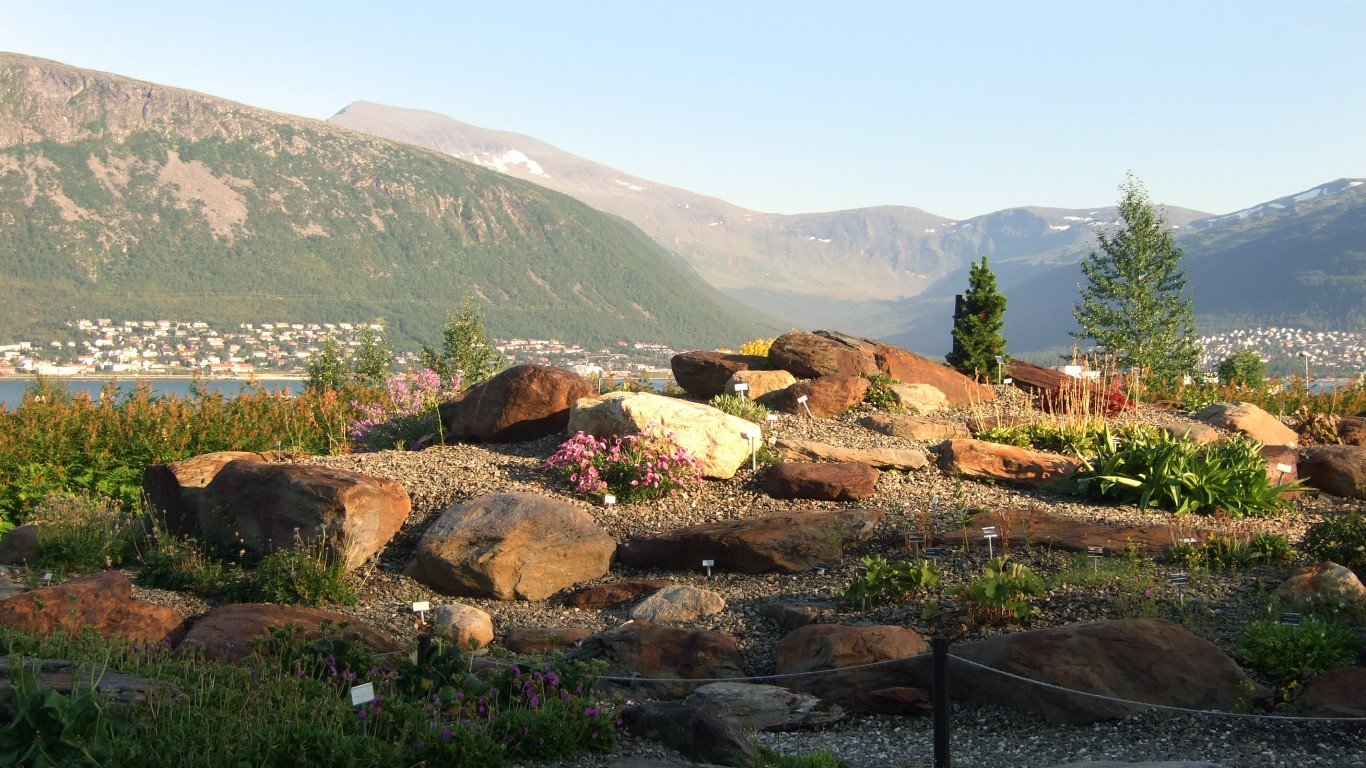
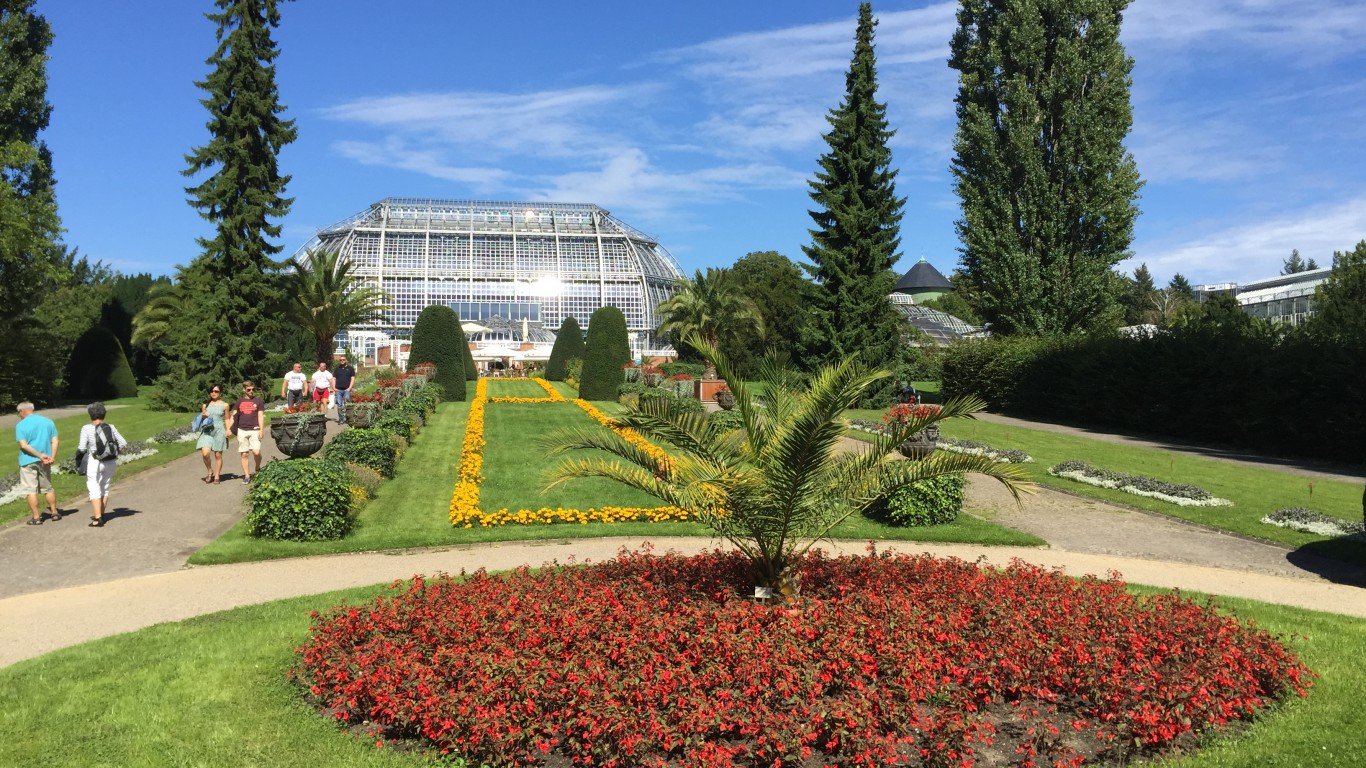

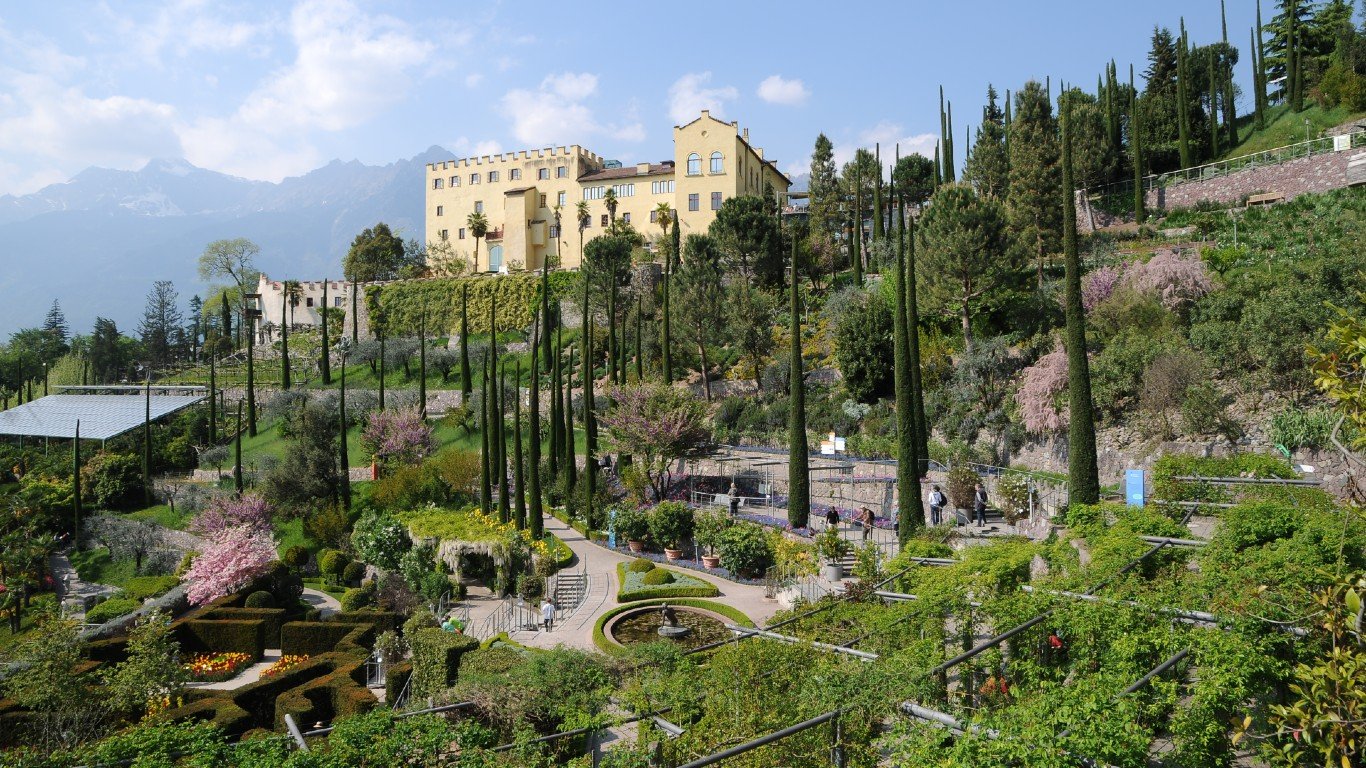
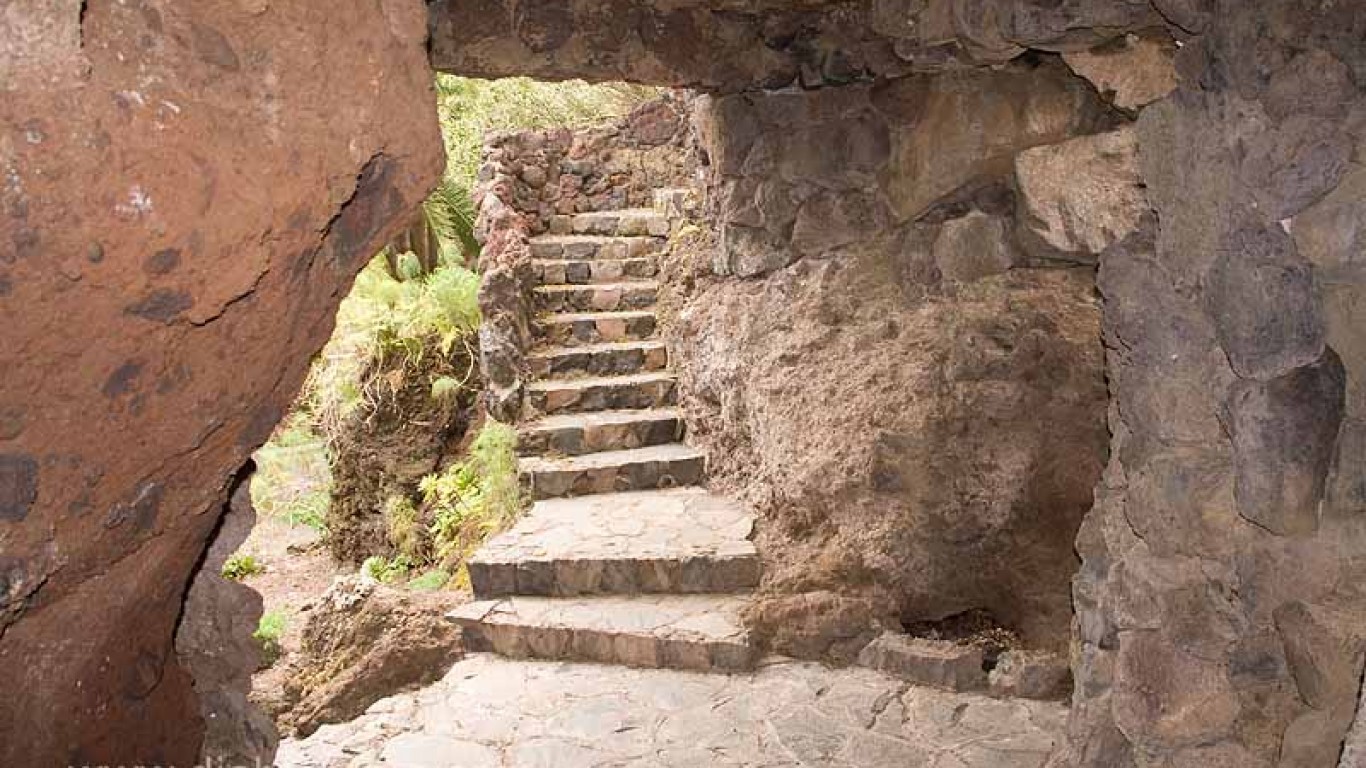
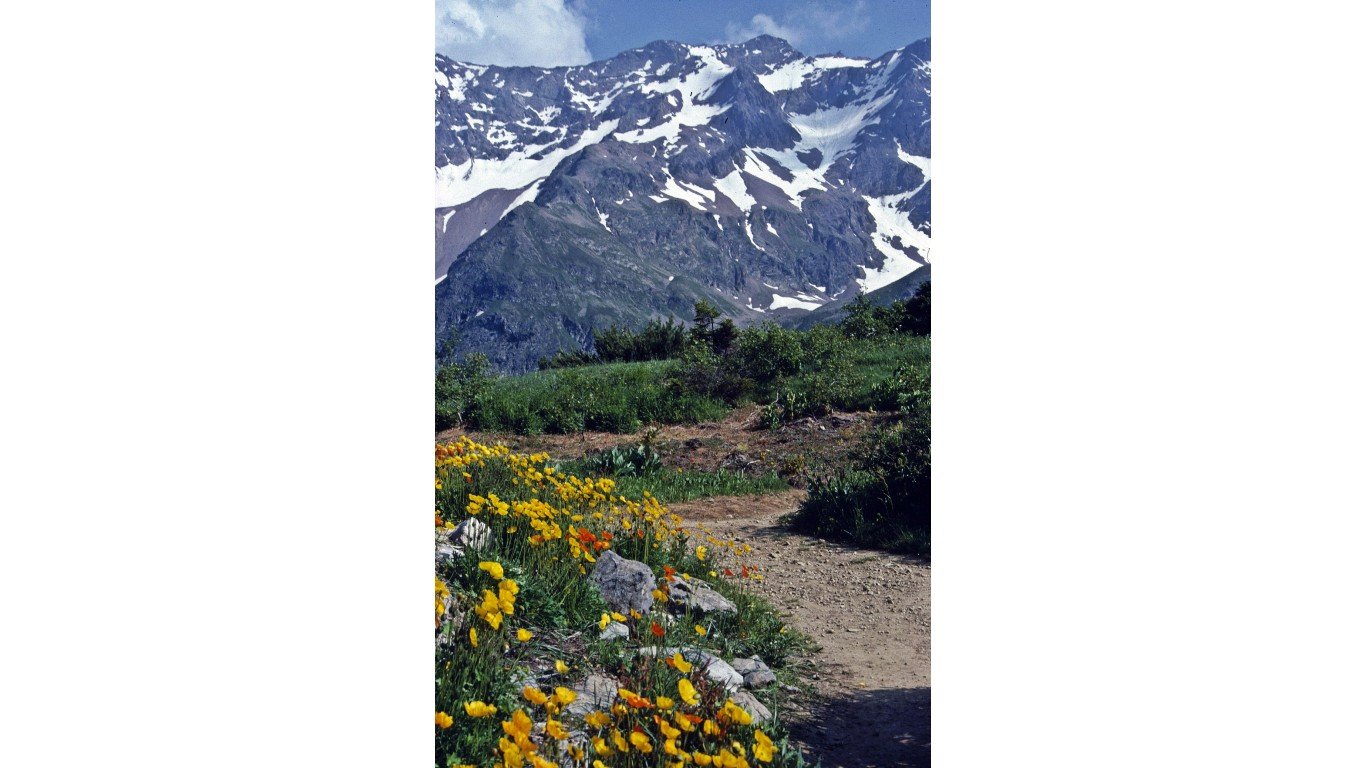
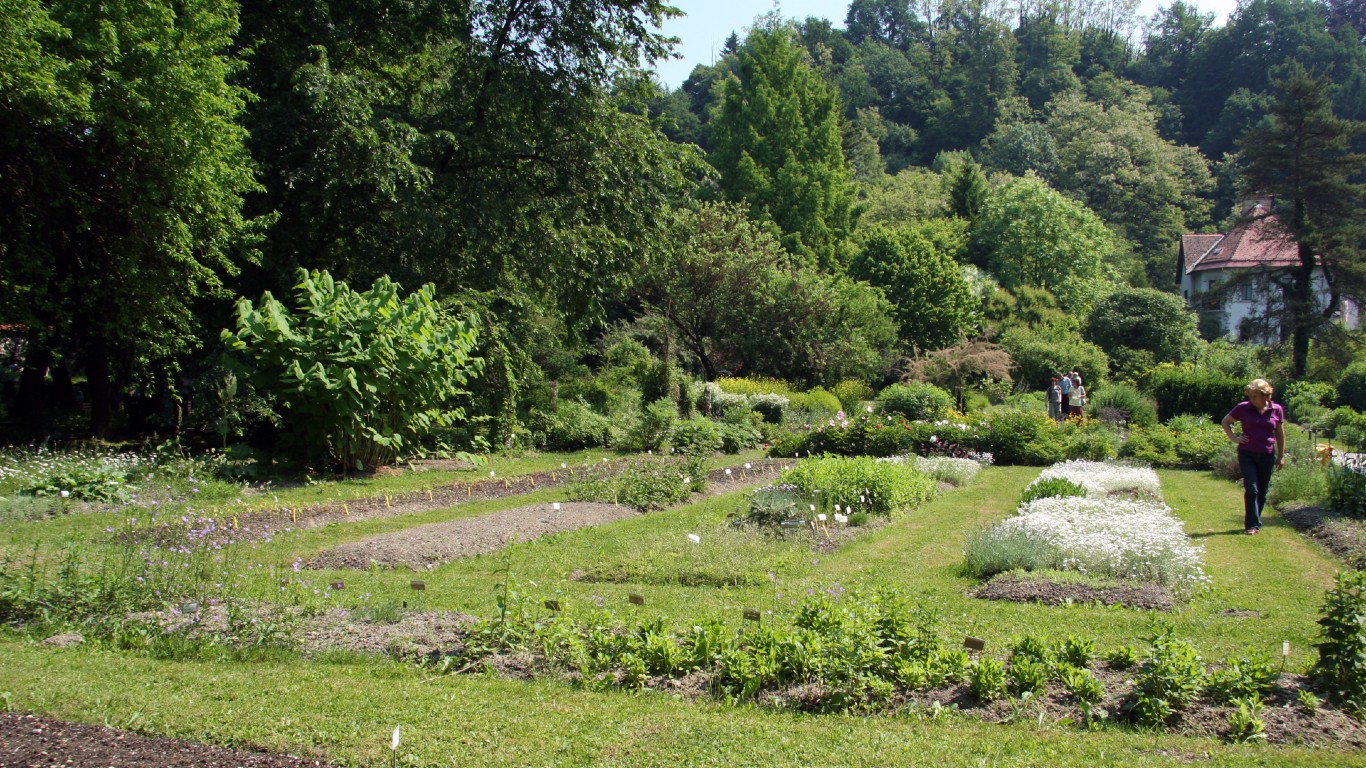
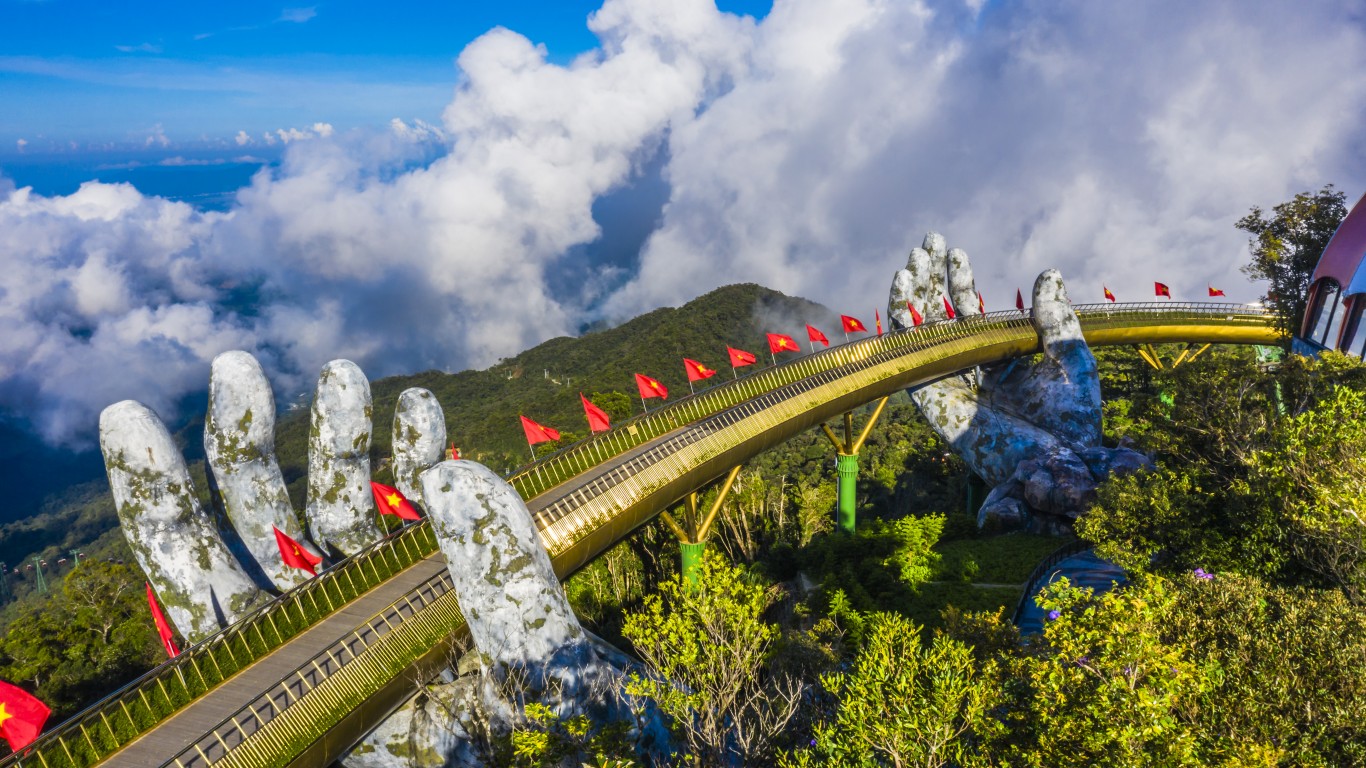 24/7 Wall St.
24/7 Wall St.